- Introduction
- Prerequisites
- Install the Connector
- Configure the Connector Global Element
- Using the Connector
- Demo Mule Applications Using ModusBox’s JDE Connector
- Demo Mule Applications Using Connector to invoke a BSFN
- Demo Mule Applications Using Connector to submit a UBE
- Demo Mule Applications Using Connector to get an UBE state
- Demo Mule Applications Using Connector to capture outbound events
- Demo Mule Applications Using Connector to capture EDI outbound events
- Connector Performance
- Resources
Introduction
The ModusBox’s JDE Connector leverages the internal capabilities of Oracle’s JD Edwards EnterpriseOne™ solution to a broader extent.
The JDE Connector aims to provide integration from and to Oracle’s JD Edwards EnterpriseOne™.
ModusBox’s JDE Connector leverages the power of Oracle’s Java Dynamic Connector to provide interoperability with Oracle’s JD Edwards EnterpriseOne™ and external systems.
After reading this guide, you should be able to accomplish the following scenarios:
-
Log into JD Edwards EnterpriseOne™
-
Invoke a BSFN on the server using proper parameters
-
Invoke a UBE by name
-
Check a UBE call’s status asynchronously
-
Poll Events
-
Poll EDI Events
-
Log out
At design time, the JDE Connector allows you to discover functions by name providing full access to all BSFN signatures. Given that discovery is a heavy duty process, the Connector manages a cache repository for all function’s metadata used at least once.
The results of a function call will be injected into the flow as a Map containing key-value pairs with the invocation’s output values. This approach gives the end user freedom of choice to construct complex flows and manage custom exception strategies.
Prerequisites
This document assumes that you are familiar with Oracle’s JD Edwards EnterpriseOne™ basics, Mule the Anypoint™ Studio interface.
Requirements
-
Mule 3.6.1 server Runtime or higher
-
Anypoint Studio January 2015 onwards
-
Access to your Oracle’s JD Edwards EnterpriseOne™ installation java libraries
Compatibility Matrix
The following matrix displays the Oracle’s JD Edwards EnterpriseOne™ Tools versions supported by version
1.1.0 |
Tool Release 8.98 Update 4. onwards |
Install the Connector
Installing
-
Launch Anypoint Studio and click on Help → Install New Software.
-
Press Add to create a new repository.
-
Type in "ModusBox Inc" in the Name field and http://modusbox.com/jde-update-site/ in the Location field
-
Expand Select and select JDE Connector. Press Next > to review the items to be installed.
-
Press Next > again to review and accept the license. Press Finish to install the connector.
-
Press OK to accept the prompted security dialog box and allow Anypoint Studio to restart.
Updating From an Older Version
If you’re currently using an older version of the connector, a small popup appears in the bottom right corner of Anypoint Studio with an "Updates Available" message.
-
Click the popup and check for available updates.
-
Click the Connector version checkbox and click Next and follow the instructions provided by the user interface.
-
Restart Studio when prompted.
-
After restarting, when creating a flow and using the Object Store Connector, if you have several versions of the connector installed, you may be asked which version you would like to use. Choose the version you would like to use.
Additionally, we recommend that you keep Studio up to date with its latest version.
It’s not necessary do any update on the flows because this update is compatible with the previous one. This version adds optional parameters to existing operation:
-
BSFN Call
-
Submit Batch Process
Configure the Connector Global Element
Preliminary Setup
In addition to meeting the requirements listed in the Prerequisites and Requirements section, a bundle has to be created to establish a connection to the JDE Enterprise Server. This bundle will be created only for the first time and it can be reused in other applications.
This adapter is a bundle of JAR files that come with the JD Edwards EnterpriseOne distribution.
These steps illustrate how to create bundle connector component so that you can include in the flow that needs connect to JDE Enterprise Server.
Step 1
Create a folder in the file system that it will include the following subfolder:
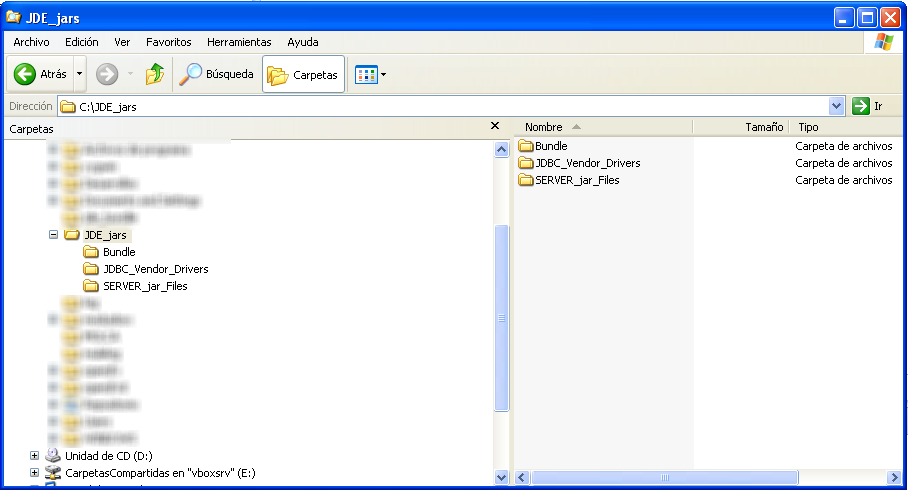
SERVER_jar_File:
In this folder we need all the jar file that come with the JD Edwards EnterpriseOne distribution. The files can be found at <Enterprise Server directory>\system\classes on the JDE Enterprise Server to which you are connecting.
For Tools Releases prior to JD Edwards EnterpriseOne Tools Release 9.1 Update 4, copy these files:
-
ApplicationAPIs_JAR.jar
-
ApplicationLogic_JAR.jar
-
Base_JAR.jar
-
BizLogicContainer_JAR.jar
-
BizLogicContainerClient_JAR.jar
-
BusinessLogicServices_JAR.jar
-
castor.jar
-
commons-httpclient-3.0.jar
-
commons-logging.jar
-
Connector_JAR.jar
-
EventProcessor_JAR.jar
-
Generator.jar
-
JdbjBase_JAR.jar
-
JdbjInterfaces_JAR.jar
-
JdeNet_JAR.jar
-
jmxremote.jar
-
jmxremote_optional.jar
-
jmxri.jar
-
ManagementAgent_JAR.jar
-
Metadata.jar
-
MetadataInterface.jar
-
PMApi_JAR.jar
-
Spec_JAR.jar
-
System_JAR.jar
-
SystemInterfaces_JAR.jar
-
xmlparserv2.jar
For JD Edwards EnterpriseOne Tools Release 9.1 Update 4 and later releases, copy the following files:
-
ApplicationAPIs_JAR.jar
-
ApplicationLogic_JAR.jar
-
Base_JAR.jar
-
BizLogicContainer_JAR.jar
-
BizLogicContainerClient_JAR.jar
-
BusinessLogicServices_JAR.jar
-
castor.jar
-
commons-codec.jar
-
commons-lang2.6.jar
-
commons-logging.jar
-
Connector.jar
-
EventProcessor_JAR.jar
-
Generator_JAR.jar
-
httpclient.jar
-
httpcore.jar
-
httpmime.jar
-
j2ee1_3.jar
-
JdbjBase_JAR.jar
-
JdbjInterfaces_JAR.jar
-
JdeNet_JAR.jar
-
jmxremote.jar
-
jmxremote_optional.jar
-
jmxri.jar
-
ManagementAgent_JAR.jar
-
Metadata.jar
-
MetadataInterface.jar
-
PMApi_JAR.jar
-
Spec_JAR.jar
-
System_JAR.jar
-
SystemInterfaces_JAR.jar
-
xml-apis.jar
-
xmlparserv2.jar
JDBC_Vendor_Drivers:
In this folder we need the JDBC driver files that correspond to the database to which you are connecting.
Bundle:
It will be an empty folder that will be used be the JD Edwards Setup to prepare the bundle jar file.
Create Mule Project
Create a new Mule Project with Mule Server 3.7.0 or larger EE as runtime:
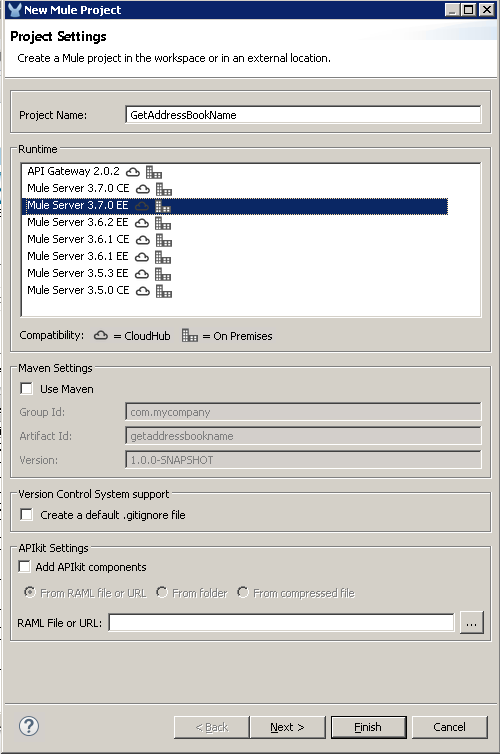
We will need this project to generate Bundle.
Generate Bundle
After create the project, you need to build the Oracle JD Edwards' lib bundle.
This jar bundle will be created once and it can be reused for all the projects that it needs connect to JD Edwards.
Step 1
Select the project created and press right mouse button to show context menu.
Select JD Edwards setup from the JDE Context Menu options.
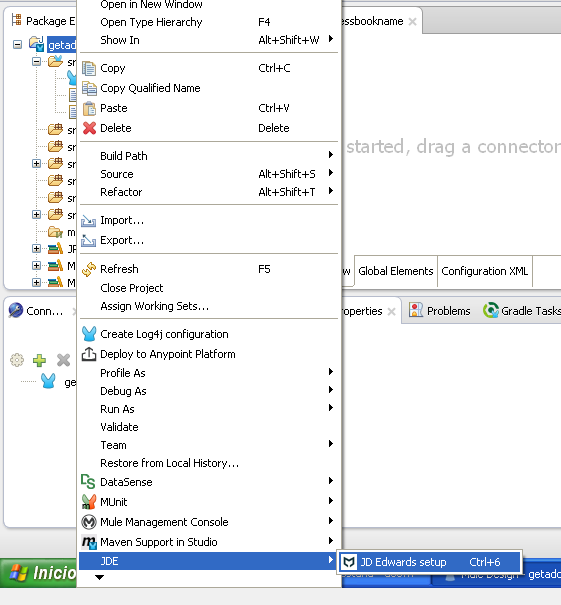
This option will open the following screen:

Step 2
In this screen you need to enter:
JDE Edwards libraries directory: the folder SERVER_jar_File created in section Preliminary Setup.
Select the JDBC driver for you vendor: The driver inside the folder JDBC_Vendor_Drivers created in section Preliminary Setup.
Target directory for your bundle: the folder Bundle created in section Preliminary Setup..

Press the button Finish and wait at the process end. You can see the advanced in the Progress tab at the bottom:

Step 3
When the process finishes, a windows show you the result.

You can open the bundle folder to see the JDE Edwards jar file generated:
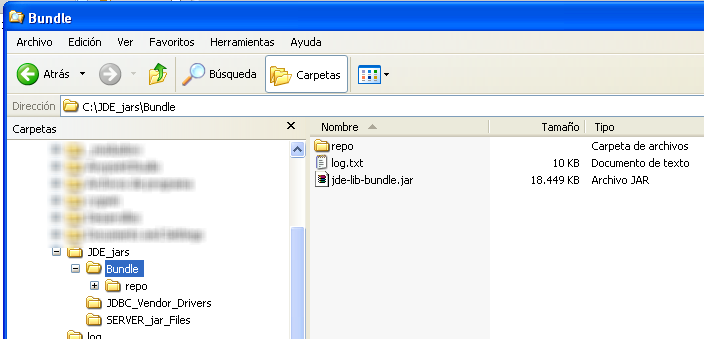
This JAR file will be used in the connector setup.
Note: If you are creating the JDE Edwards bundle from a Maven Project, the jar file will be in the Maven Repository. Folder [MAVEN REP]com\jdedwards\jde-lib-bundle\[Version]
Copy JDE ini Files inside the Project
The JDE Connector relies on Oracle’s Java Dynamic Connector to establish the link to the server. In order to achieve this, setting up the follwing standard configuration files is needed:
-
"jdbj.ini"
-
"interop.ini"
-
"jdelog.properties"
-
"tnsnames.ora" (for Oracle RDBMS based installations only)
These files are distributed with both Fat Clients or Enterprise Server modules.
In case you get the files from a Fat Client, the folder containing them can be found under the path ini/sbf of your installation.
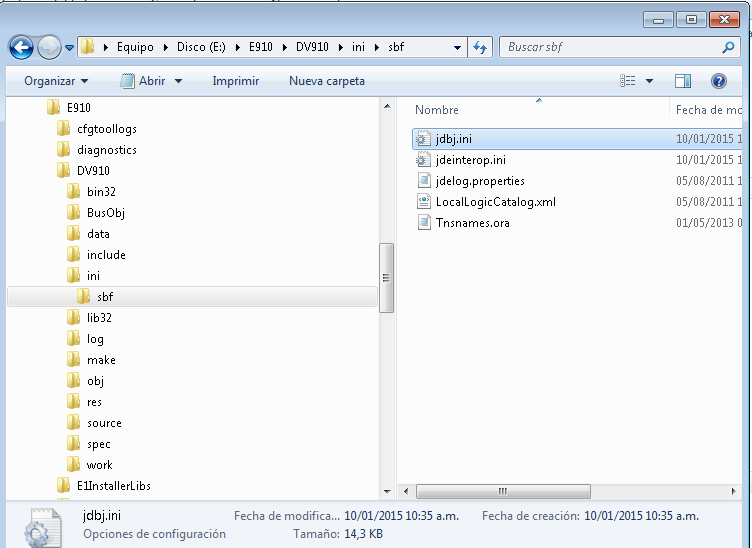
Step 1
Put the files inside the project folder in the folder:
-
source/main/resource
-
root folder of the project
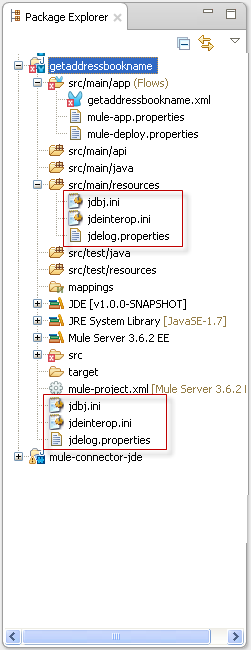
Step 2
Edit jdeinterop.ini, jdelog.properties, and jdbj.ini for proper settings.
Refer to the Guide "JD Edwards EnterpriseOne Tools Connectors Guide"
Configure Global Element
To use the ModusBox’s JDE Connector in your Mule application, you must configure a global ModusBox’s JDE Connector element that can be used by the ModusBox’s JDE Connector (read more about Global Elements).
The ModusBox’s JDE Connector offers the following global configuration(s), requiring the following credentials:
General → Connection
| Field | Description |
|---|---|
User |
Enter JDE User used to initialize the JDE Session. |
Password |
Enter Password used to authenticate the JDE user |
Environment |
Enter JDE Environment |
Role |
Enter JDE User Role |
General → Check Enable DataSense
General → Required Dependency
| Field | Description |
|---|---|
Oracle JD Edwards' Lib Bundle |
Select Jar File generated in section Generate Bundle or include maven reference. (See below) |
Specs Image Settings → Spec Image
| Field | Description |
|---|---|
Folder Specs Image Cache |
Select folder to save specs locally |
To include the Oracle JD Edwards' lib bundle generated previously:
Press button Add File and select JD Edwards' bundle created.
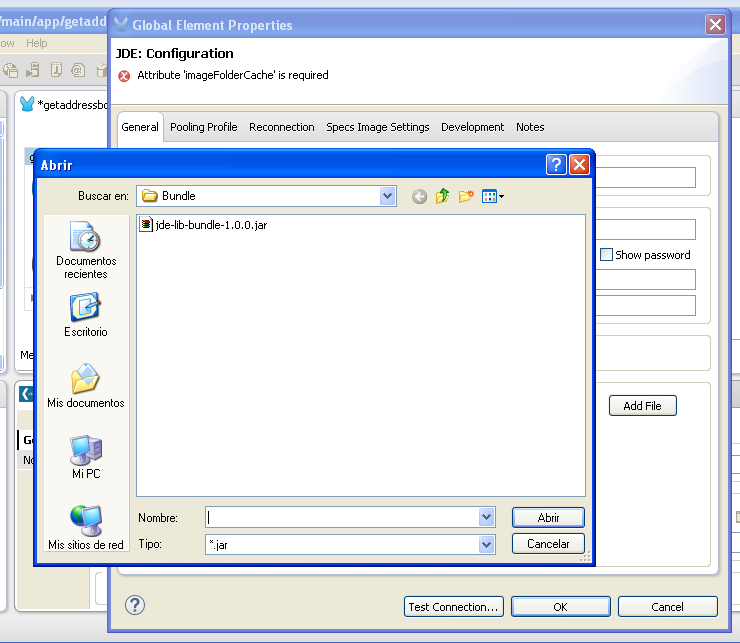
the result will be:

For Maven Project:

Press button Add Dependency and select JD Edwards' bundle created.
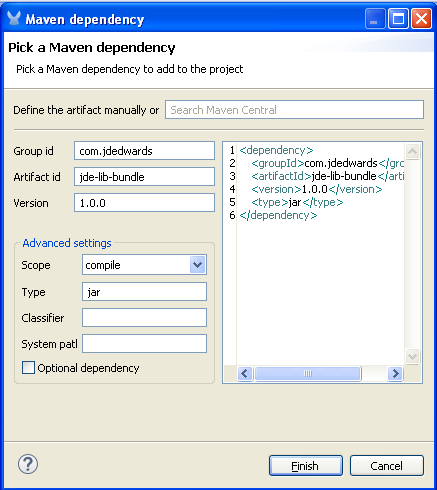
the result will be:
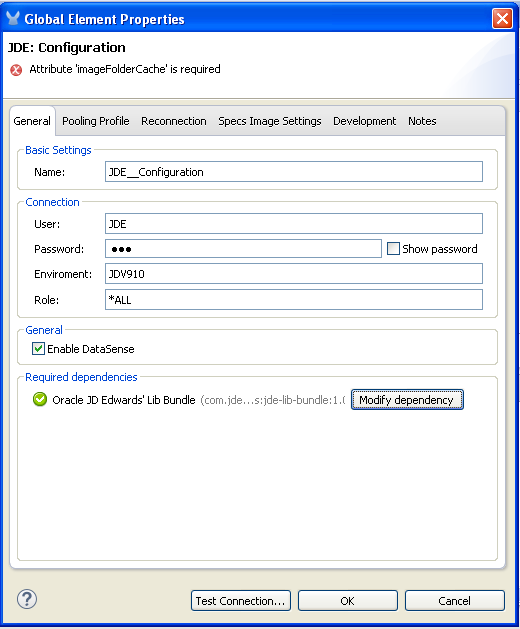
Before continue, you need to test connection pressing TEST CONNECTION… button
Using the Connector
You can use the connector to
-
Invoke a BSFN on JD Edwards Enterprise Server
-
Submit a UBE
-
Get UBE Job Status for a UBE using JDE Job Id.
-
Get Outbound Events from a JD Edwards Application
-
Get EDI Event from EDI Application
Connector Namespace and Schema
When designing your application in Studio, the act of dragging the connector from the palette onto the Anypoint Studio canvas should automatically populate the XML code with the connector namespace and schema location.
Namespace: http://www.mulesoft.org/schema/mule/jde
Schema Location: http://www.mulesoft.org/schema/mule/jde http://www.mulesoft.org/schema/mule/jde/current/mule-jde.xsd
If you are manually coding the Mule application in Studio’s XML editor or other text editor, define the namespace and schema location in the header of your Configuration XML, inside the <mule> tag.
|
1
2
3
4
5
6
7
8
9
10
11
12
<mule xmlns="http://www.mulesoft.org/schema/mule/core"
xmlns:xsi="http://www.w3.org/2001/XMLSchema-instance"
xmlns:jde="http://www.mulesoft.org/schema/mule/jde"
xsi:schemaLocation="
http://www.mulesoft.org/schema/mule/core
http://www.mulesoft.org/schema/mule/core/current/mule.xsd
http://www.mulesoft.org/schema/mule/connector
http://www.mulesoft.org/schema/mule/jde http://www.mulesoft.org/schema/mule/jde/current/mule-jde.xsd">
<!-- put your global configuration elements and flows here -->
</mule>
Using the Connector in a Mavenized Mule App
If you are coding a Mavenized Mule application, this XML snippet must be included in your pom.xml file.
1
2
3
4
5
<dependency>
<groupId></groupId>
<artifactId></artifactId>
<version></version>
</dependency>
|
Inside the
|
Demo Mule Applications Using ModusBox’s JDE Connector
-
Invoke a BSFN
-
Invoke a UBE
-
Get UBE Job Status
-
Get Outbound Events from a JD Edwards Application
-
Get EDI Event to generate Order Acknowledgments 855 EDI Doc
Using the JDE Connector in your application is explained in detail in the Example Use Case section below.
Demo Mule Applications Using Connector to invoke a BSFN
This use case example will create a simple flow to get the address book name from the Address Book table (A/B) invoking the Master Business Function (MBF) on Oracle’s JDE EnterpriseOne Server.
Step 1
Use Mule Project created in the Section 4.2 Create Mule Project.
Step 2
Locate the HTTP Endpint connector on the right hand-side palette:

Step 3
Drag the connector over to the canvas:
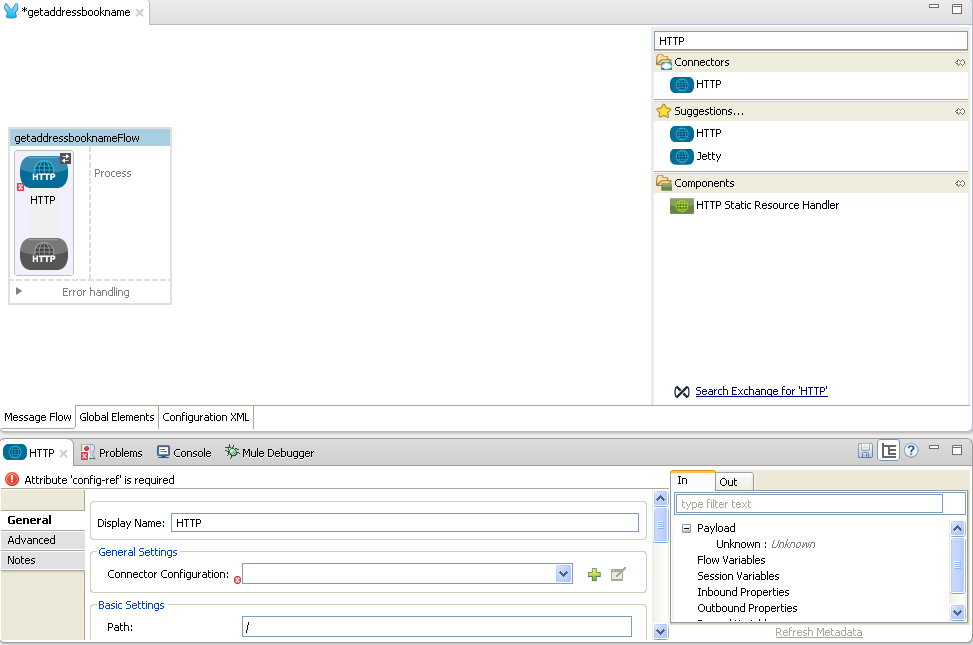
Step 4
The connector requires an Connector Configuration; click on Add to create a connector configuration.
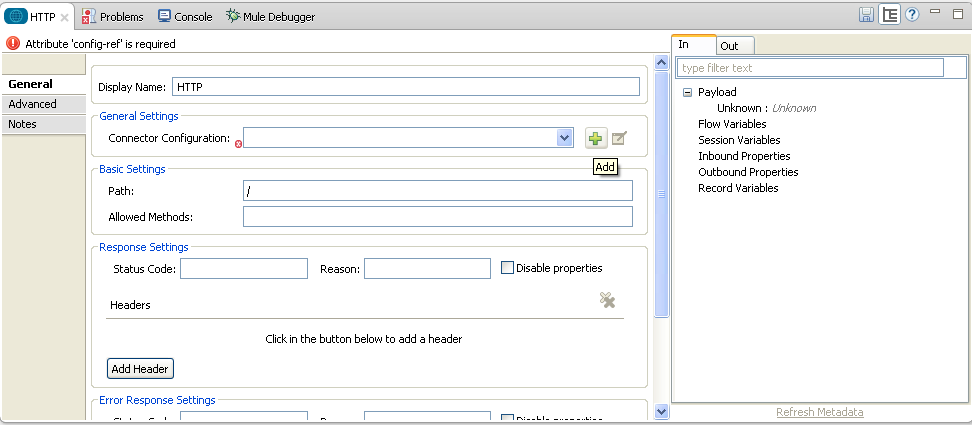
Step 5
Give the HTTP endpoint a more descriptive name like “get-AddressBookName-http-endpoint” and press OK to go back to the global HTTP endpoint dialog box:

Step 6
Add a path to the URL like "getaddressbookname" and press SAVE the project. The connector will be ready to process requests.
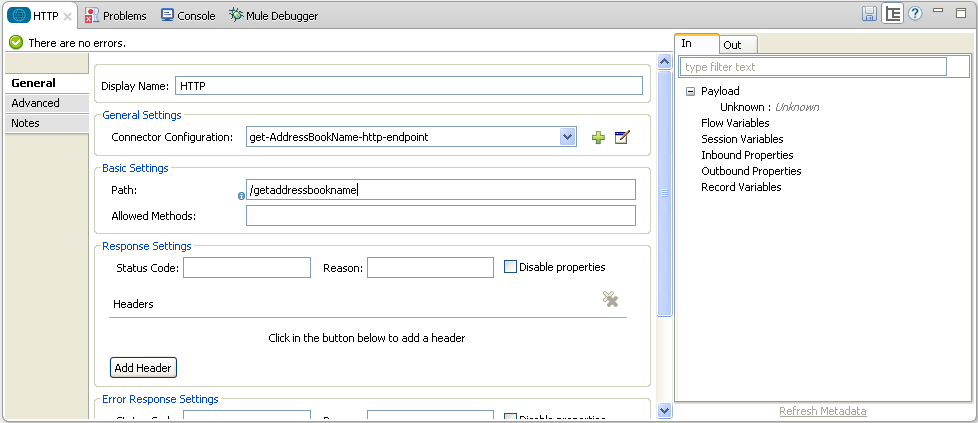
Step 7
Back to the Message Flow view, you need to Locate the JDE Connector on the right hand-side palette:
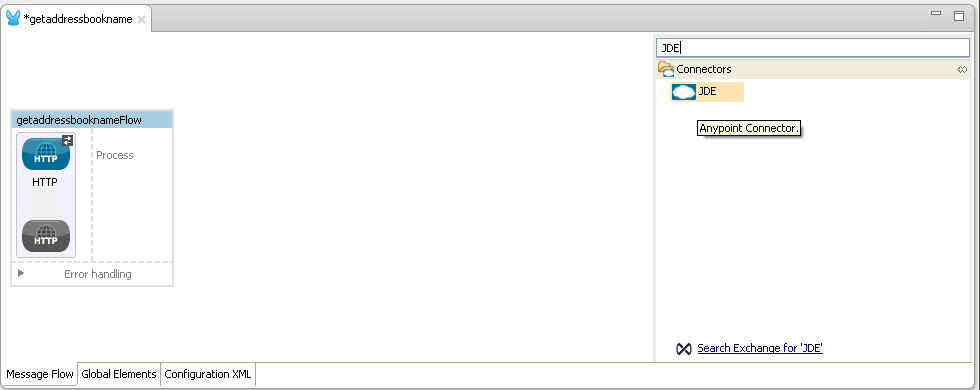
Step 8
Drag the connector over to the canvas:
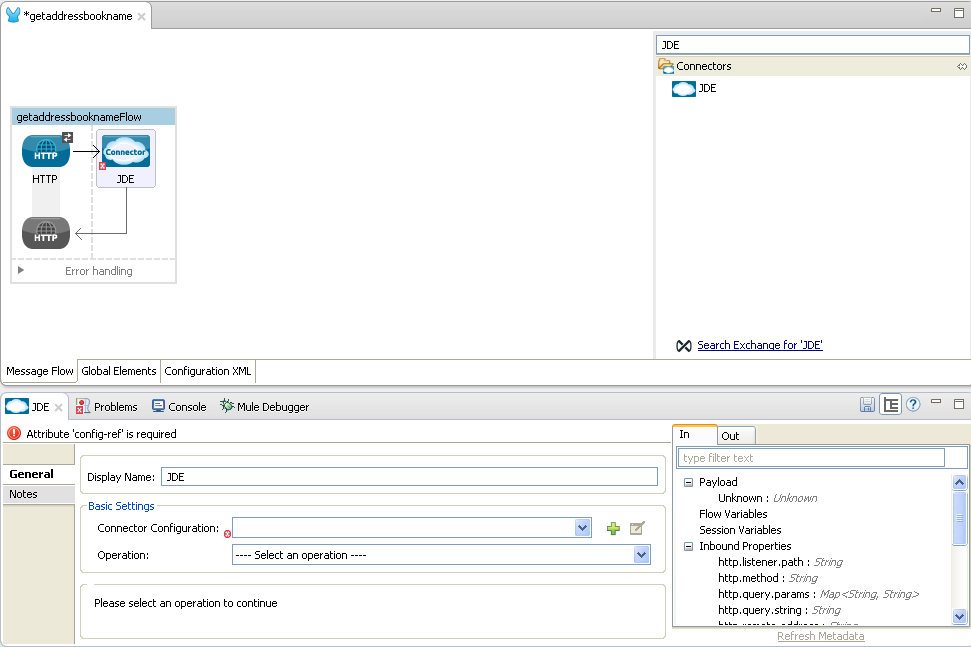
Step 9
You need to select Connector Configuration created in section 4:

Step 10
You need to select the operation "Call object"
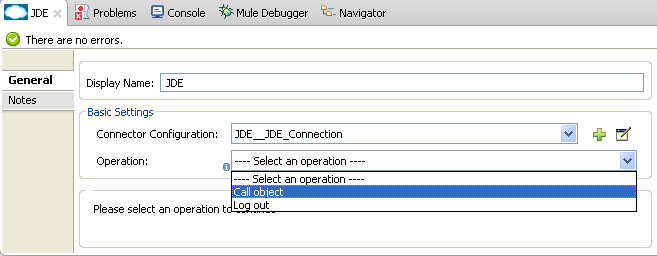
Step 11
Now, you need to write the bsfn to call in the Entity Type field and press ENTER:
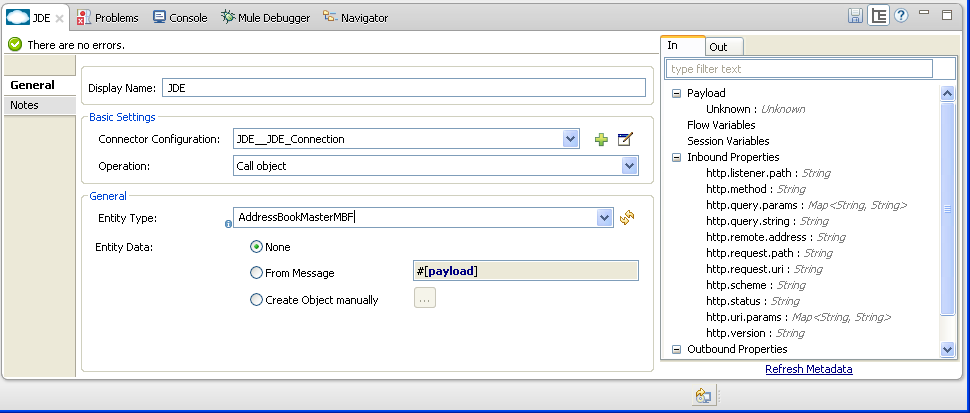
The connector will get the specification from the server and it will put the specification in the local repository.
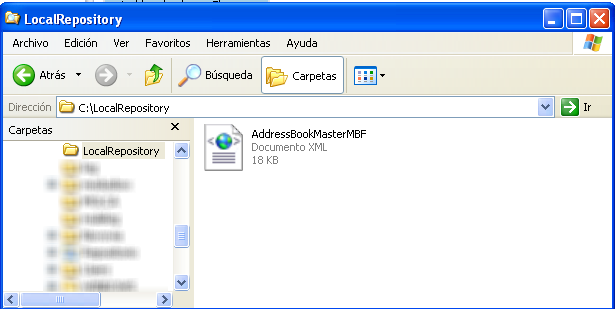
Step 12
After the connector get the specs from the server, you will need to populate the parameters. To do this, you need to select the option: Create Object manually
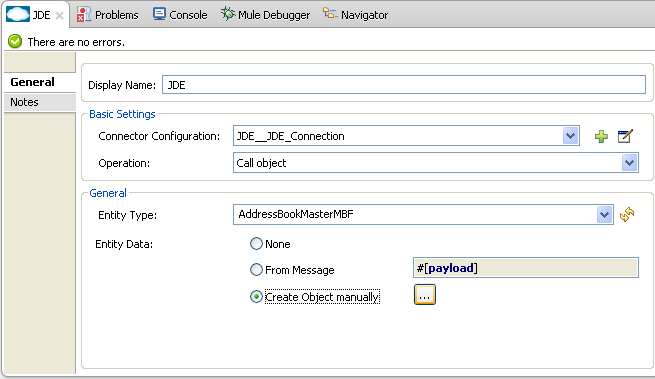
Press the button […] and populate the parameters:
Action Code to "I" Inquire
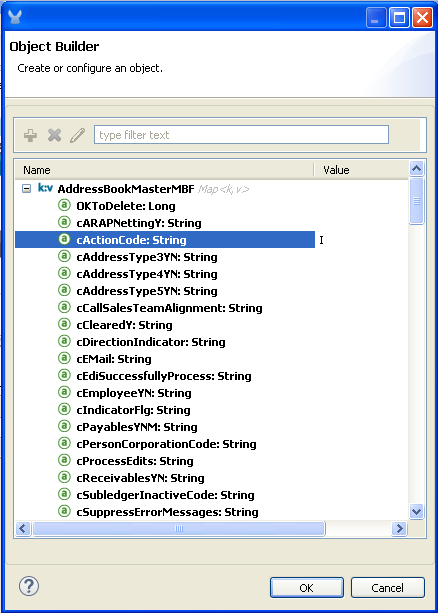
And Address Book Number the address number that will be part of the URL parameter.
Ex: localhost:8081/getaddressbookname?addressbook=1
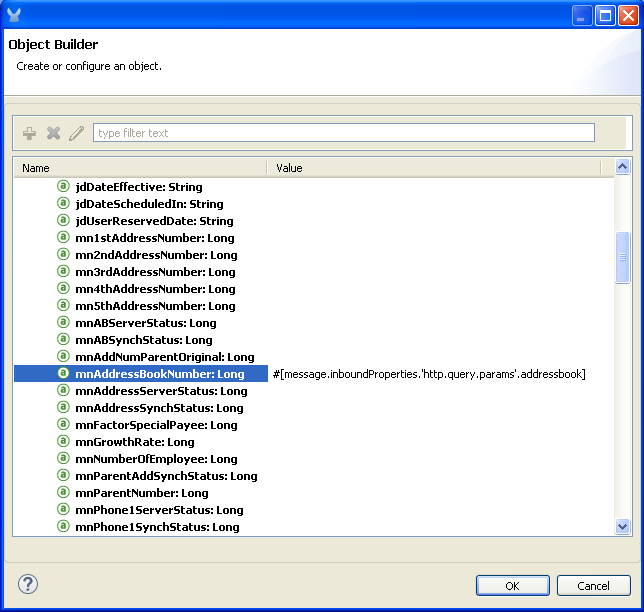
Press OK button to return to JDE Connector configuration. Save the project.
Step 13
Back to the Message Flow view, and you need to Locate the Set Payload on the right hand-side palette to return the address book name.

Step 14
Drag the Transformer over to the canvas and write the answer.
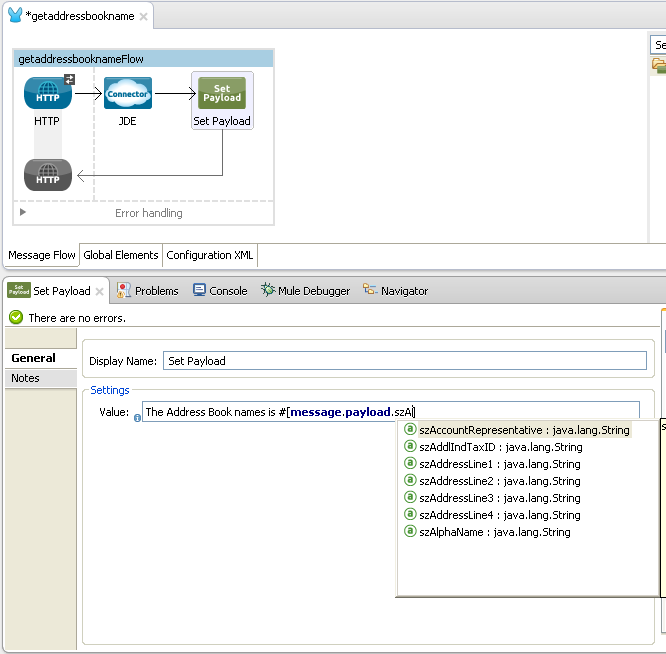
The answer will be:
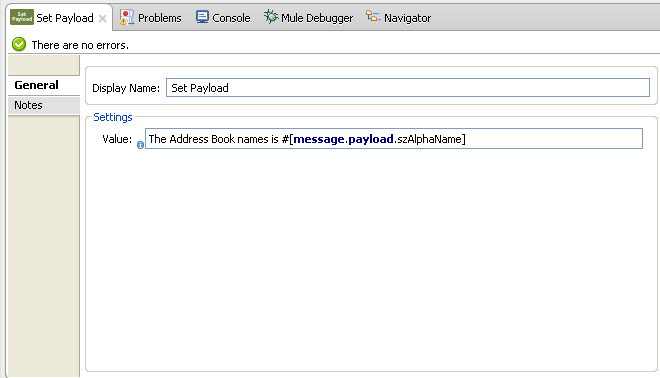
Step 15
Finally, run the example as a Mule application
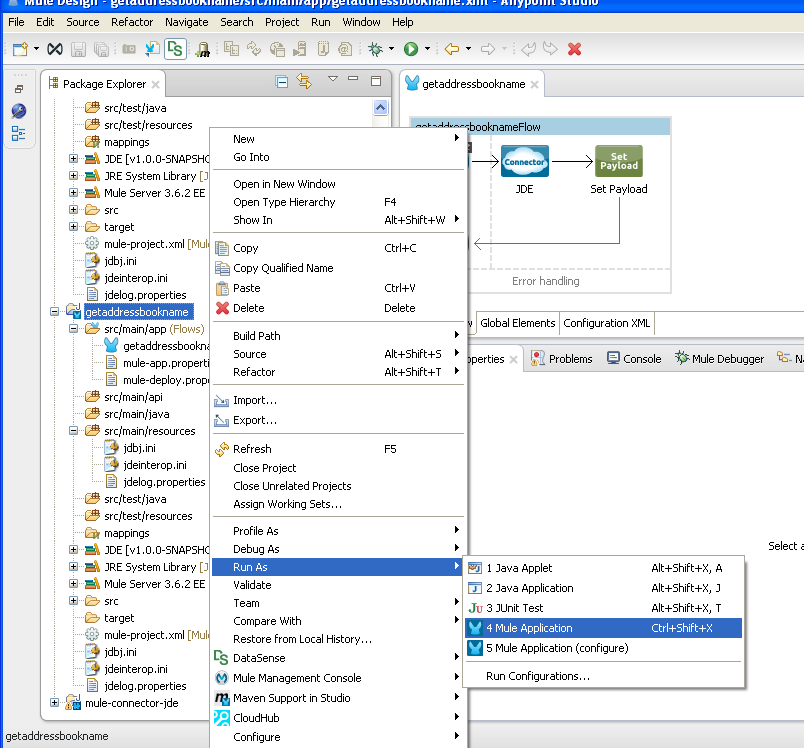
Step 16
Test the Mule Application
Write the URL:
localhost:8081/getaddressbookname?addressbook=1

How to use common Call BSFN parameters
There is 4 common parameters to invoke a BSFN:
| Parameter | Input/Output | Type | Description |
|---|---|---|---|
_BSFNThrowExceptionWithErrorsYN |
Input |
STRING |
Values: Y, The flow will throw Runtime Eexception with cause: org.mule.modules.jde.exceptions.JDEBfsnError. |
_BSFNReturnCode |
Output |
INTEGER |
Values: 0: Processed Correctly, 1: There is warnings, 2: There is errors. |
_BSFNNumberOfErrors |
Output |
INTEGER |
Number of errors |
_BSFNDetailErrors |
Output |
LIST |
Detail of the error. It return ArrayList<CallObjectErrorItem> |
This is an example of CallObjectErrorItem object:
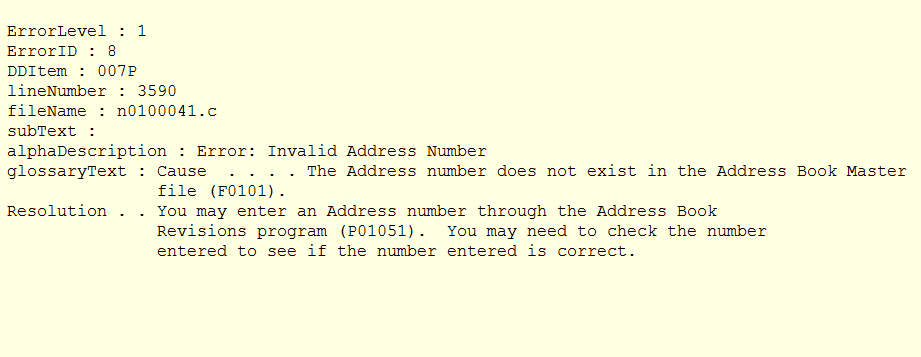
Demo Mule Applications Using Connector to submit a UBE
This use case example will create a simple flow to submit an UBE to JDE Enterprise Server.
Step 1
Use Mule Project created in the Section 4.2 Create Mule Project.
Step 2
Locate the HTTP Endpoint connector on the right hand-side palette:
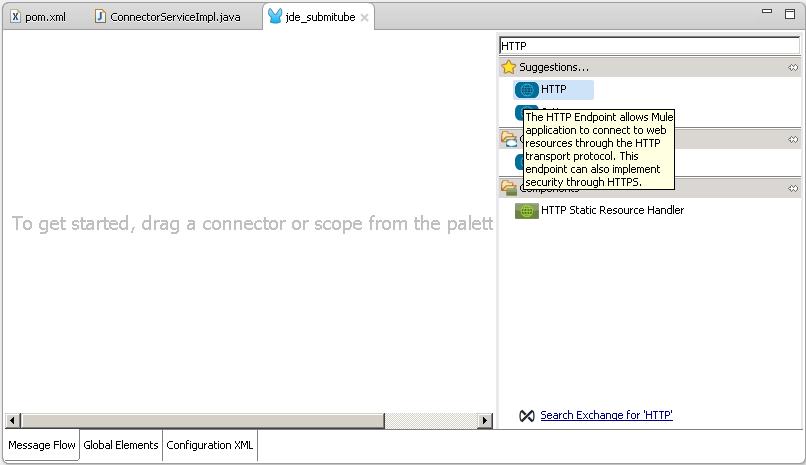
Step 3
Drag the connector over to the canvas:
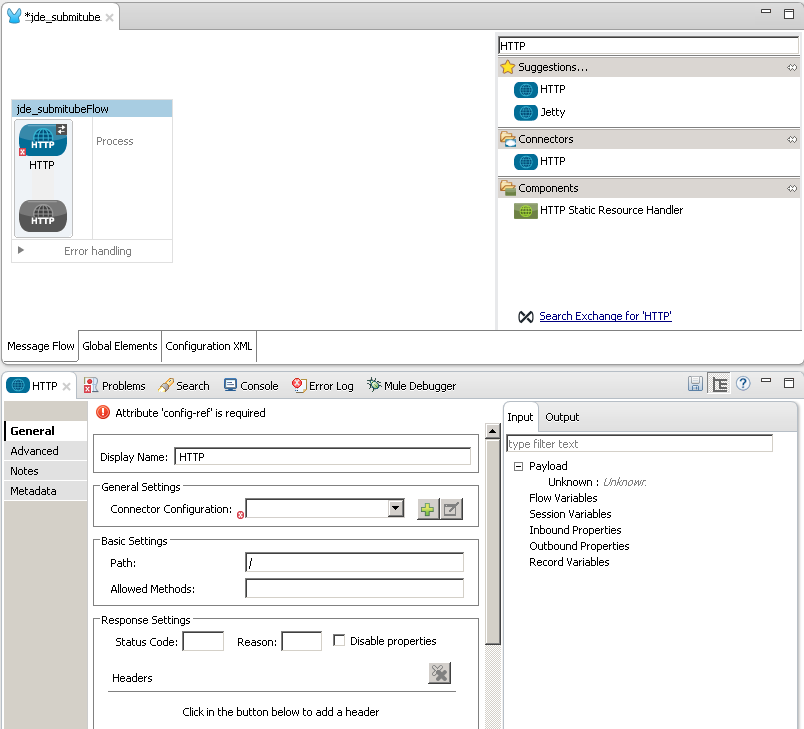
Step 4
The connector requires an Connector Configuration; click on Add or to create a connector configuration.
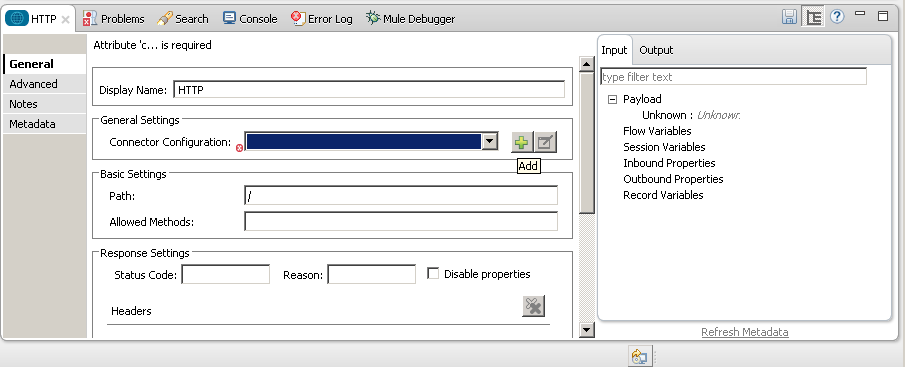
Step 5
Give the HTTP endpoint a more descriptive name like “SubmitUBE-http-endpoint” and press OK to go back to the global HTTP endpoint dialog box:
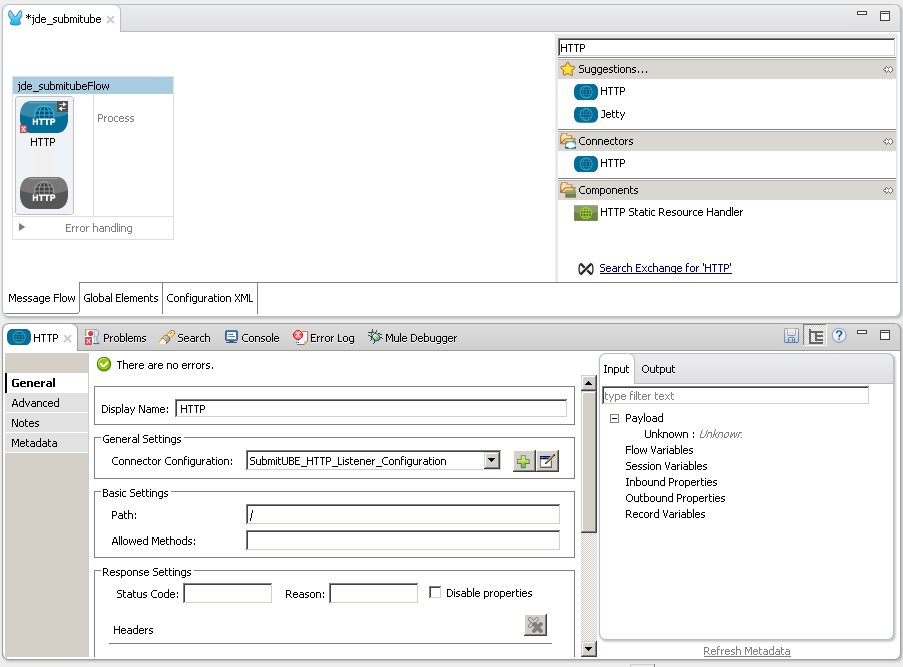
Step 6
Add a path to the URL like "submitube" and press SAVE the project. The connector will be ready to receive request.

Step 7
Back to the Message Flow view, you need to Locate the JDE Connector on the right hand-side palette:
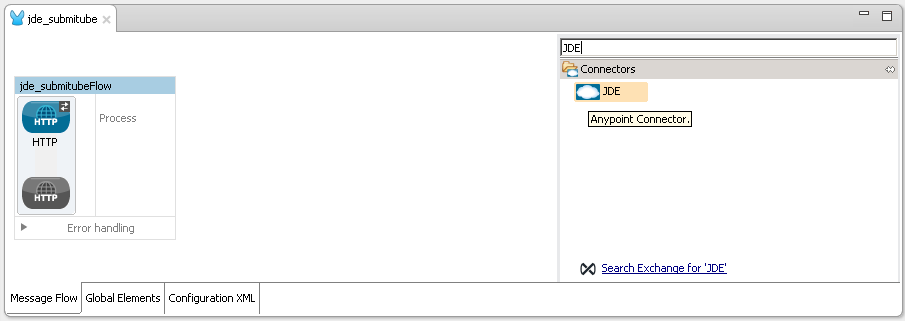
Step 8
Drag the connector over to the canvas:
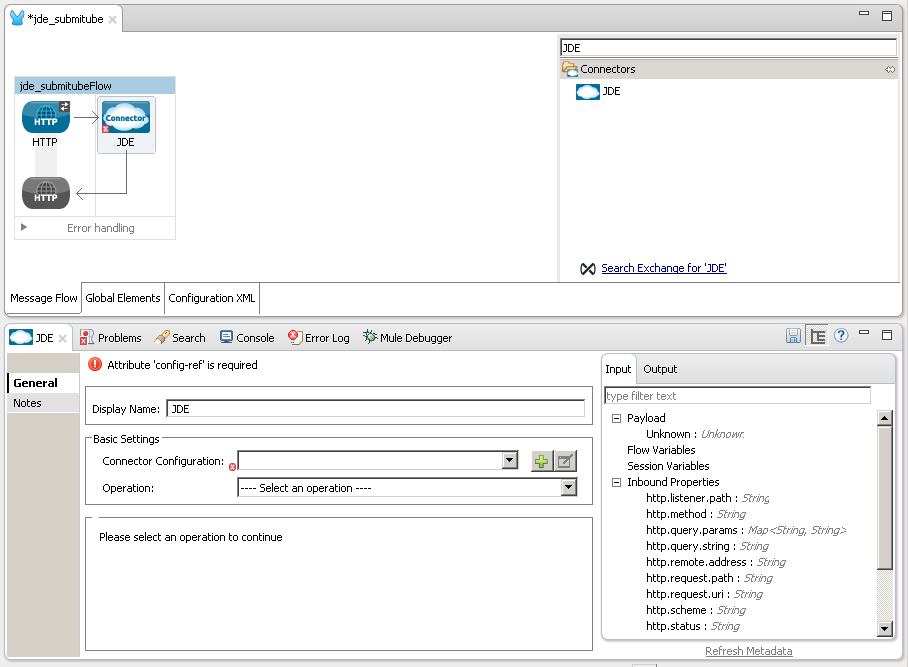
Step 9
You need to select Connector Configuration created in section 4:
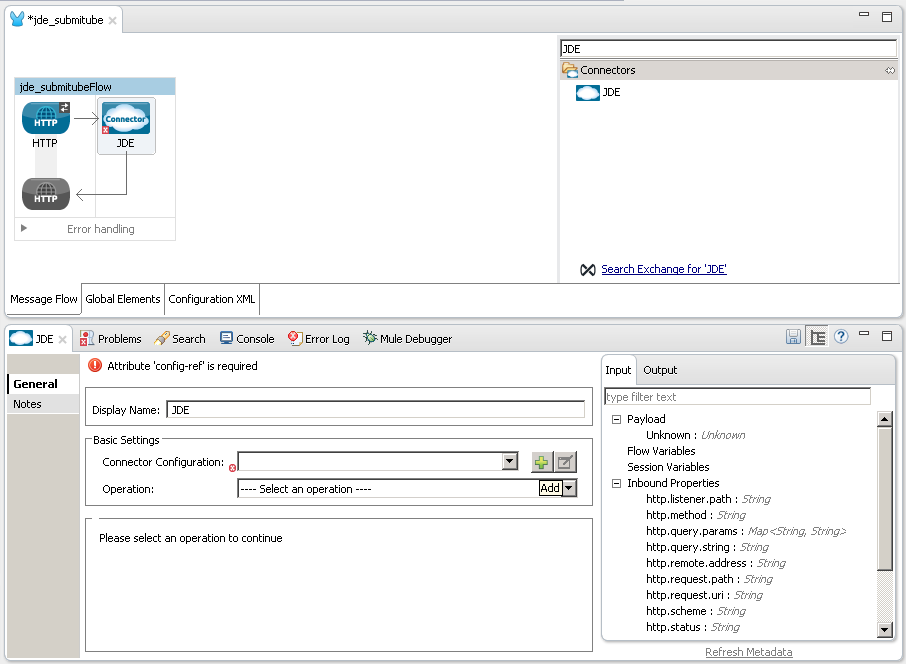
Step 10
You need to select the operation "Submit batch process"
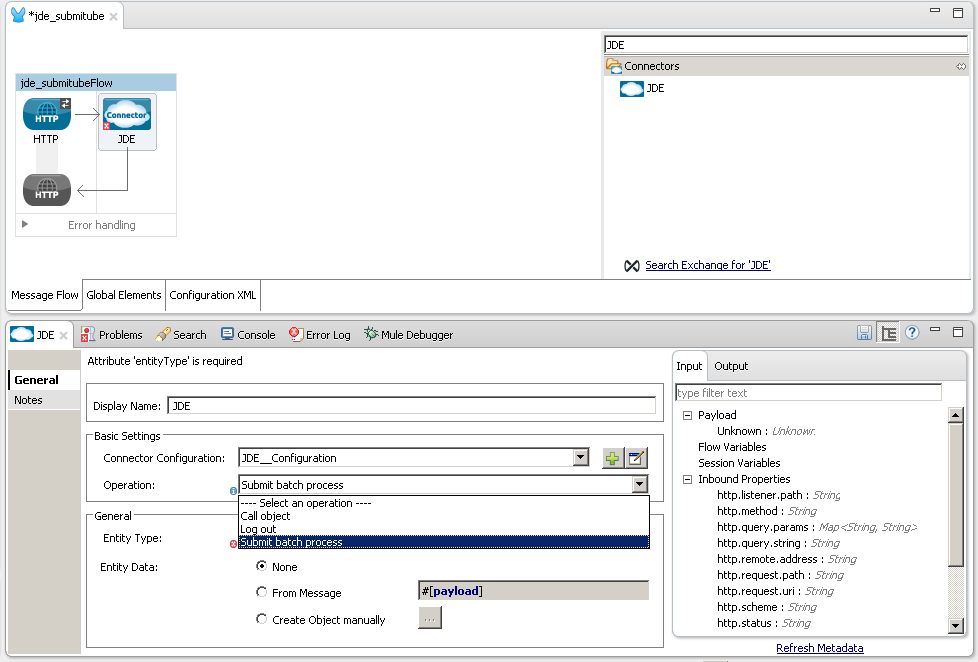
Step 11
Now, you need to write the UBE/Version to submit in the Entity Type field and press ENTER:
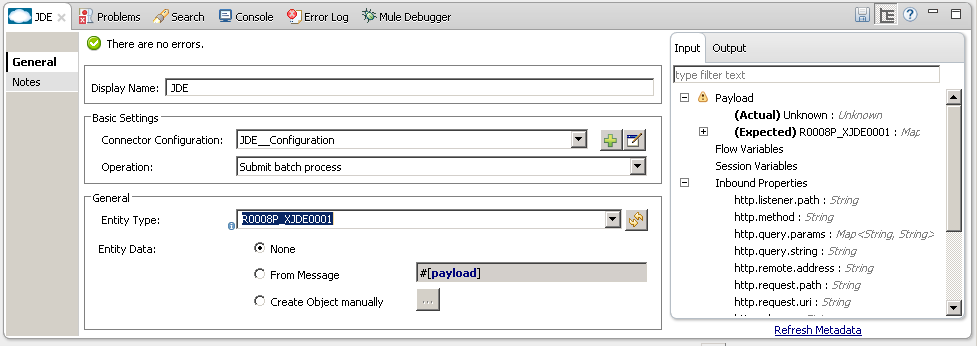
The connector will get the specification from the server and it will put the specification in the local repository.
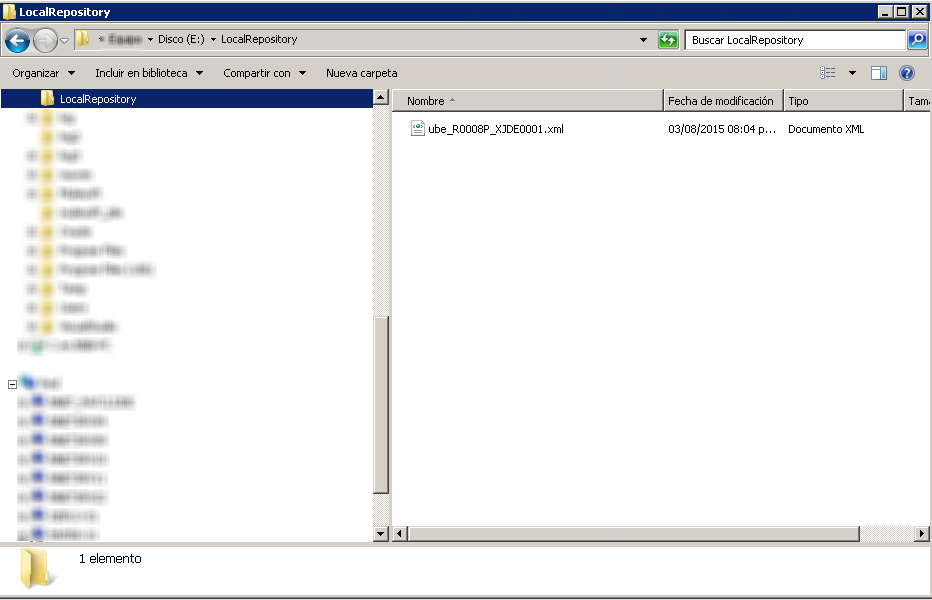
Step 12
After the connector get the specs from the server, you will need to populate the parameters. To do this, you need to select the option: Create Object manually

Press the button […] and populate the parameters:
_Job Queue: Enter the Job Queue or empty if you prefer default job queue for the UBE selected
_Selection: F0010.CO = ''00000''
cFiscalDatePattern: F
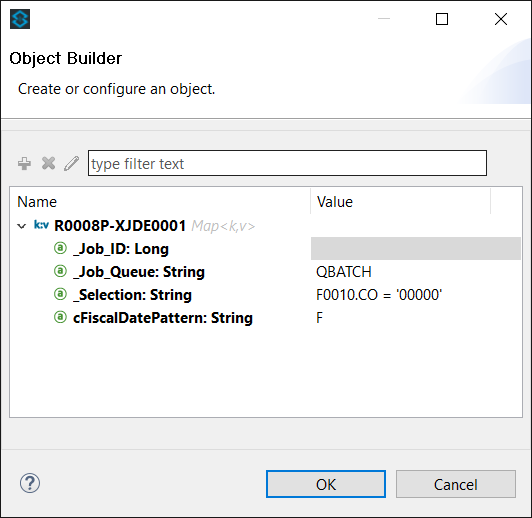
Press OK button to return to JDE Connector configuration. Save the project.
Step 13
Back to the Message Flow view, and you need to Locate the Set Payload on the right hand-side palette to return the address book name.

Step 14
Drag the Transformer over to the canvas and write the answer.
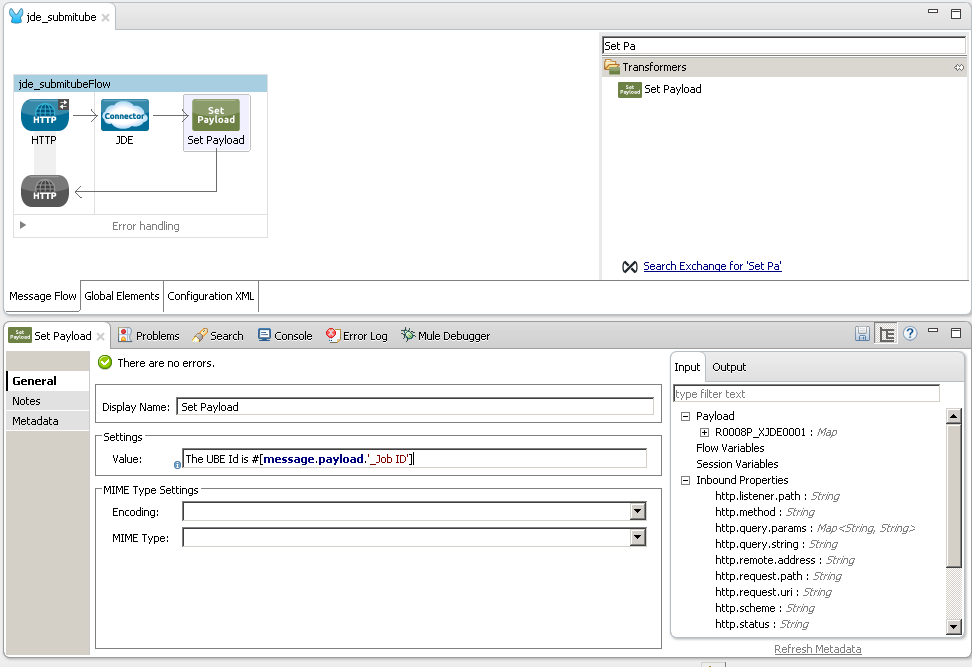
Step 15
Finally, run the example as a Mule application

Step 16
Test the Mule Application
Write the URL:
localhost:8082/submitube
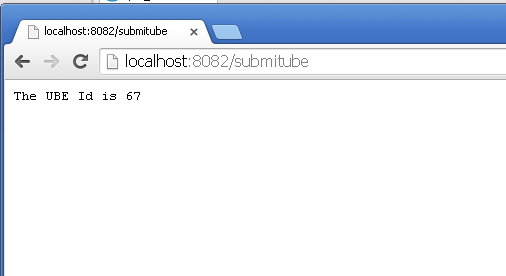
Step 17
Check Work Submit Job from E1
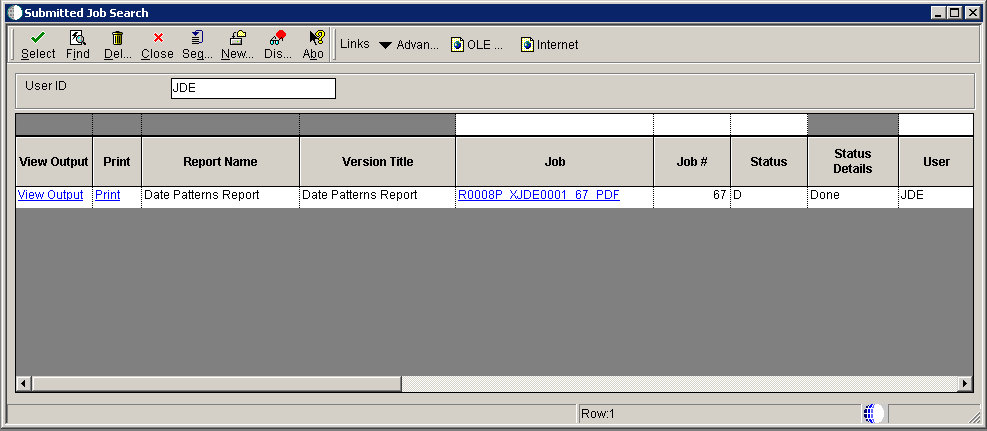
How define Data Selection
The parameter _Selection is used to define UBE Data Selection.
The sentence is like a WHERE of SQL sentence.
The _Sentence syntax is:
table.column_name operator [value|table.column_name];The table must be a JDE table that it belong to main view. Column Name must be an JDE’s Alias.
The following operators can be used in the _Sentence:
| Operator | Description |
|---|---|
= |
Equal |
<> |
Not equal |
<> |
Not equal |
> |
Greater than |
< |
Less than |
>= |
Greater than or equal |
⇐ |
Less than or equal |
BETWEEN |
Between an inclusive range |
NOT BETWEEN |
Not Between an exclusive range |
IN |
To specify multiple possible values for a column |
NOT IN |
To exclude multiple possible values for a column |
The values can be literals or another column table.
Literals can be String or Number
The sentence can include AND condition and the OR condition
To override the default precedence you need to use parenthesis as:
C1 AND (C2 OR C3)The sentence only accept one level of Parenthesis.
For example, this is a valid sentence because the maximum level of Parenthesis opened is 1.
C1 AND (C2 OR C3) AND (C4 OR C5)otherwise, this is an invalid sentences because the maximum level of Parenthesis opened is 2.
C1 AND (C2 OR (C3 AND C4))Examples:
F4211.KCOO = '00001' AND F4211.DOCO > 10332 F4211.KCOO = '00001' AND F4211.DOCO >= 10332 F4211.KCOO = '00001' AND F4211.DOCO <= 10332 F4211.KCOO = '00001' AND F4211.DOCO <> 10332 F4211.KCOO = '00001' AND ( F4211.DCTO = 'SO' OR F4211.DCTO = 'SI' ) F4211.KCOO = '00001' AND F4211.DCTO IN ('SO','SI') F4211.KCOO = '00001' AND F4211.DCTO NOT IN ('SO','SI') F4211.KCOO = '00001' AND F4211.DOCO BETWEEN 1022 AND 400 F4211.KCOO = '00001' AND F4211.DOCO NOT BETWEEN 1022 AND 400 F4211.MCU = F4211.EMCU AND F4211.DOCO NOT BETWEEN 1022 AND 400Demo Mule Applications Using Connector to get an UBE state
This use case example will add an control to the previous example to get an UBE state from JDE Enterprise Server after Submit UBE.
Step 1
Back to the Message Flow view, you need to Locate the Session Variable on the right hand-side palette:
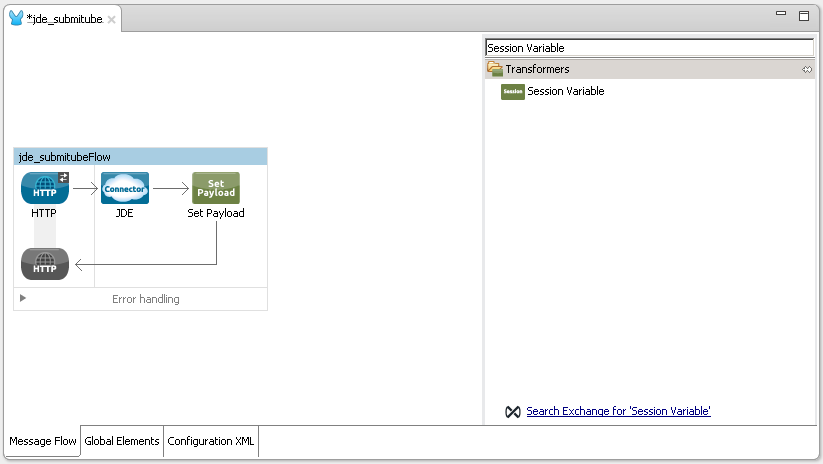
Step 2
Drag the Transformer over to the canvas after JDE Connector:
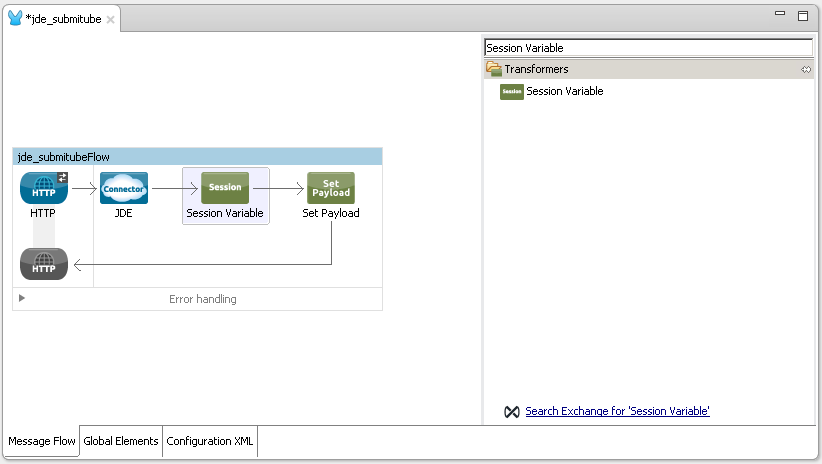
We use this transformer to save the JOB ID generated by the previous UBE Submit.
Edit Session Variable and add the following values:
Display Name: Save JOB ID
Name: JobIDSaved
Value: #[message.payload._Job_ID]
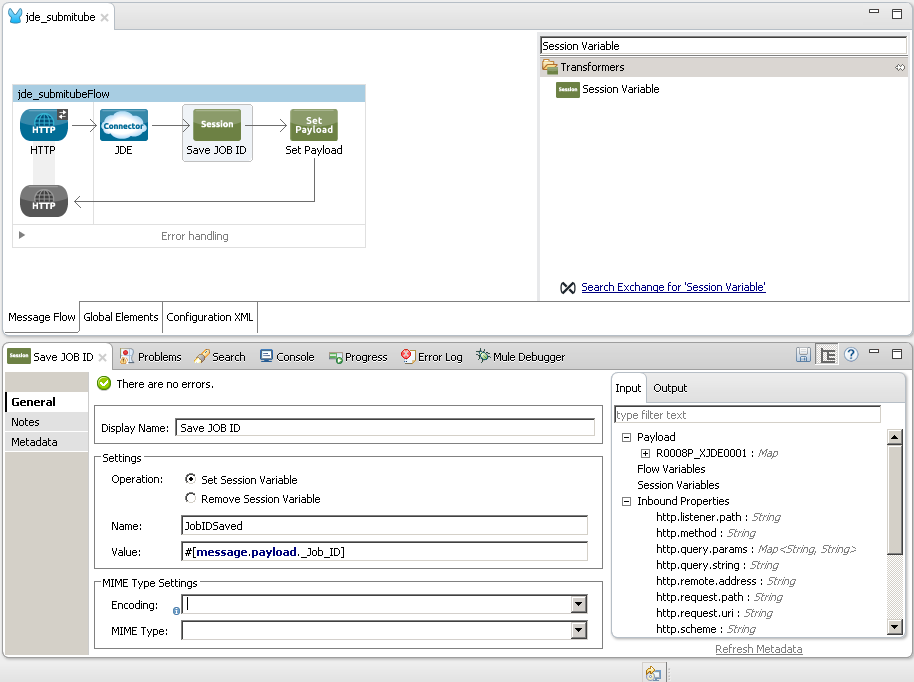
Step 3
Back to the Message Flow view, you need to Locate the JDE Connector on the right hand-side palette:
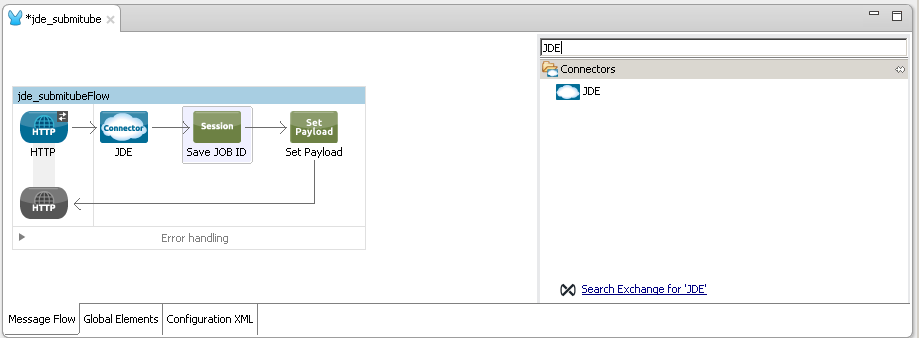
Step 4
Drag the connector over to the canvas after Session Variable Save JOB ID:
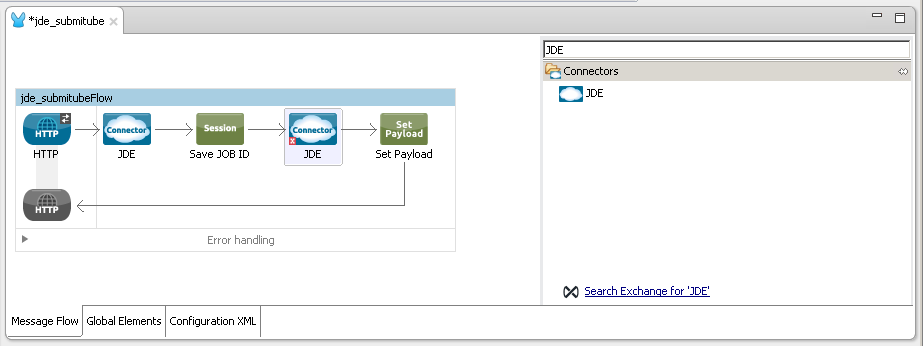
Step 5
You need to select the same Connector Configuration as previous connector.
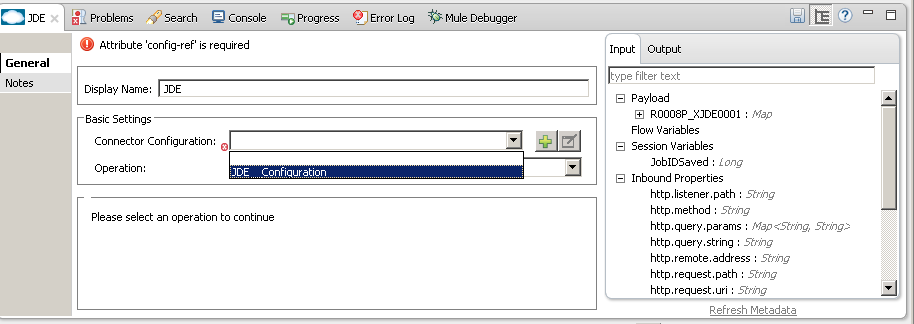
Step 6
You need to select the operation Get batch process information

Step 7
Refresh metadata and select Get Job Status

Step 8
You will need to populate the parameters. To do this, you need to select the option: Create Object manually and press the button […]:
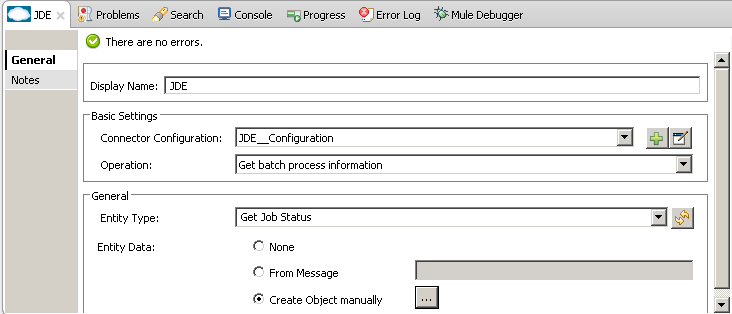
Populate the parameters:
Set Job_ID to value: #[sessionVars.JobIDSaved]
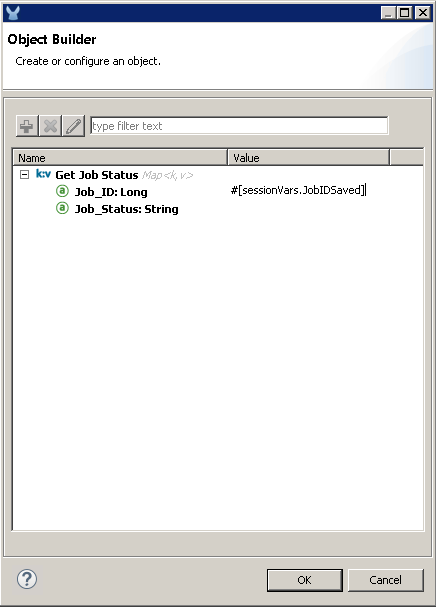
Step 9
Update the last "Set Payload" with the following value:
The UBE Id is #[sessionVars.JobIDSaved] and the status is: #[payload.Job_Status]

Step 10
Finally, run the example as a Mule application
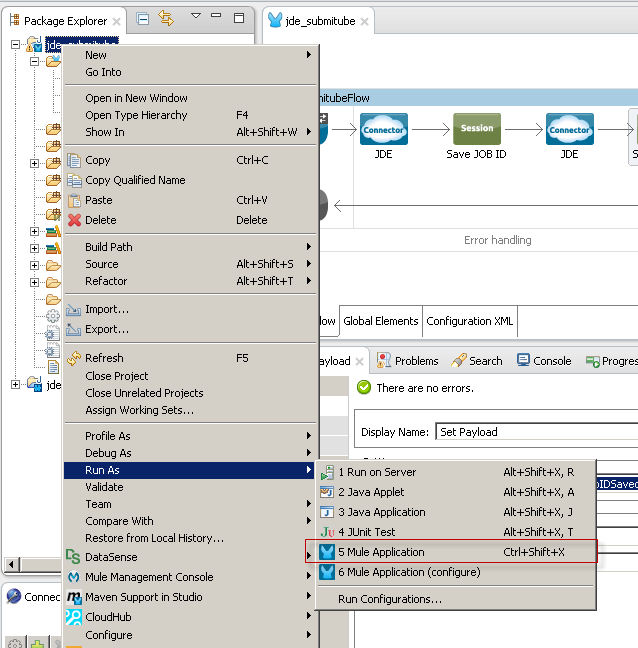
Step 11
Test the Mule Application
Write the URL:
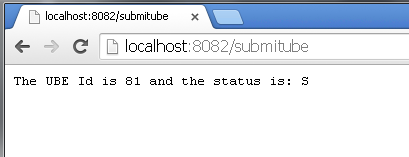
The possible values of job status are:
| Status | Description |
|---|---|
S |
In Queue |
W |
Waiting |
P |
Processing |
D |
Done |
E |
Error |
H |
Hold |
Demo Mule Applications Using Connector to capture outbound events
This use case example will create a simple flow to get outbound events that it come from an application that uses a Master Business Function to generate transactions.
JDE outbound transactions requires that you set a Processing Option specifying a transaction type. Additionally, some entry programs enable you to specify a version of the Master Business Function Processing Options program that, in turn, enables you to specify a version of the Interoperability Processing Options program.
For example, to get customer entered by the application Customer Master information (P03013) is necessary setup the following Processing Options:
Versions -> Customer Master MBF (P0100042) Version with the value ZJDE0002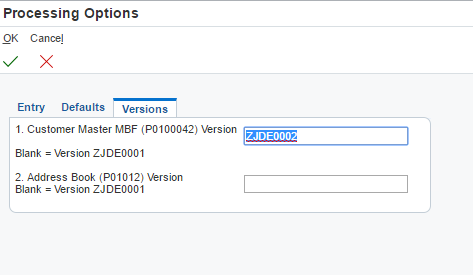
Then, the P0100042 version ZJDE0002 needs to have the following value in
Outbound -> Transaction Type with the value JDECM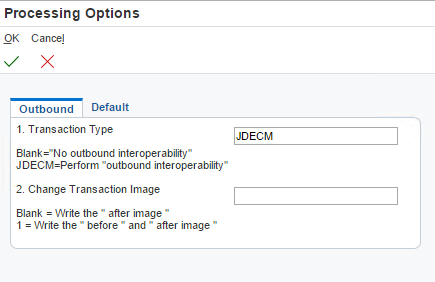
The last configuration that is needed is inform to JDE connector the outbound table used by the MBF to inform the event:
Using "Flat File Cross-Reference (P47002)" form "Work With Flat File Cross-Reference" adds the following record:
| Table | Record Type |
|---|---|
F03012Z1 |
1 Header |
Follow next steps to create a flow that it will capture Customers that it added using Customer Master information (P03013)*
| For more Outbound Interoperability alternatives from JDE you need to read JD Edwards EnterpriseOne Applications Interoperability Fundamentals Implementation Guide |
Step 1
Use Mule Project created in the Section 4.2 Create Mule Project.
Step 2
Locate the Poll Endpoint connector on the right hand-side palette:
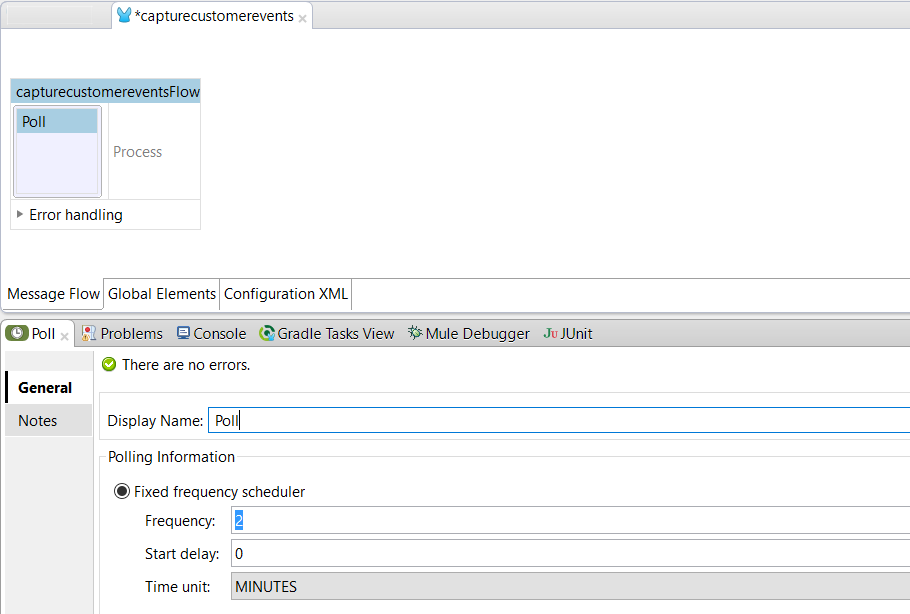
Step 3
Drag the JDE connector over to the canvas:
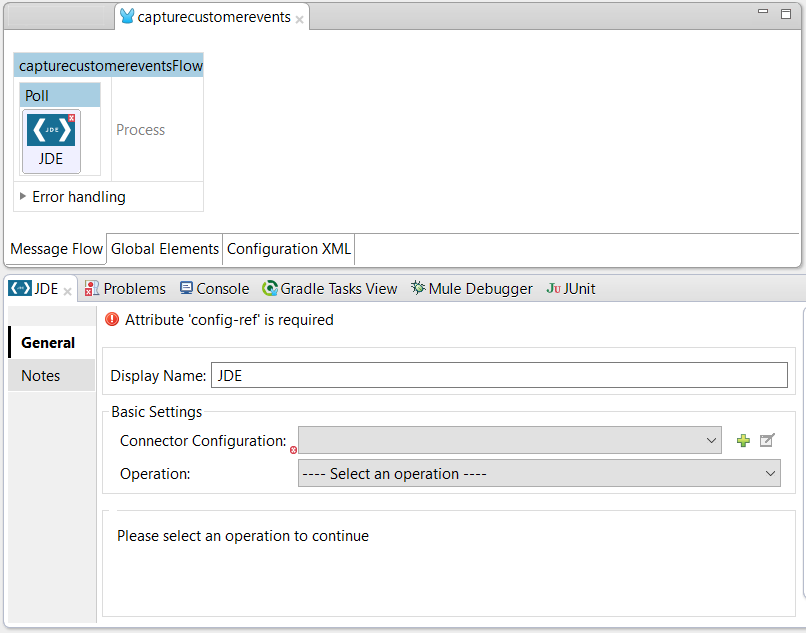
Step 4
You need to select the operation "Poll Events"
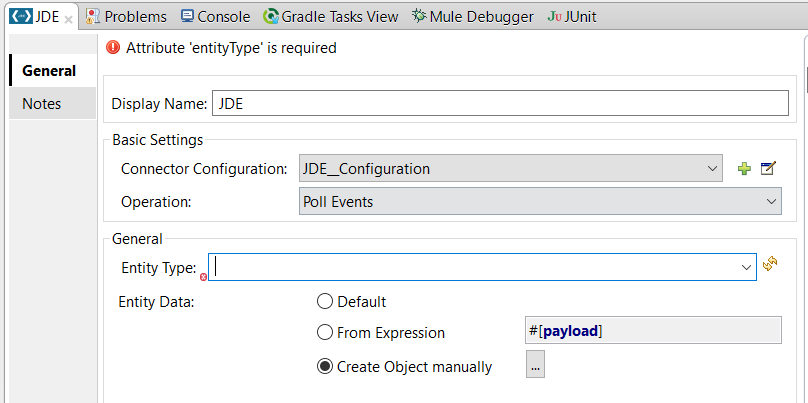
Step 5
Now, you need to select "Capture Event Transactions" in the Entity Type field and press ENTER:
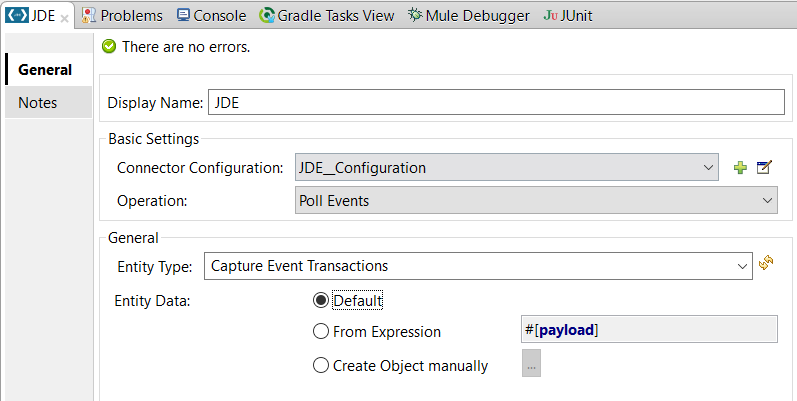
Step 6
Now, You will need to populate the parameters. To do this, you need to select the option: Create Object manually
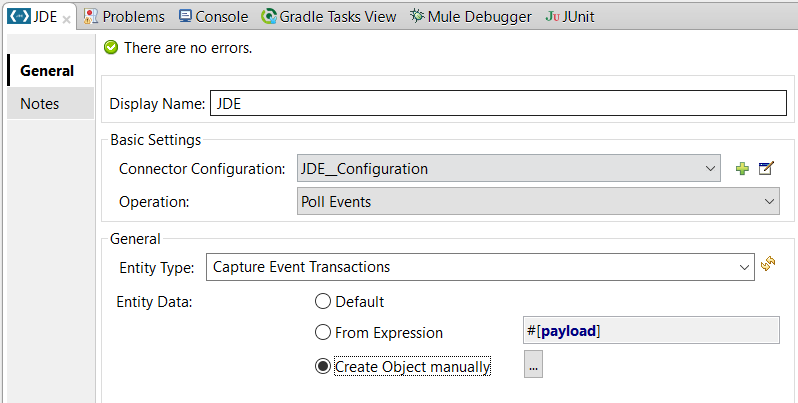
Press the button […] and populate the parameters:
Transaction Code Enter JDECM value
Max Qty Transactions to Read Enter 3 value
Last Batch Number (EDBT): #['']

Press OK button to return to JDE Connector configuration. Save the project.
Step 7
Back to the Message Flow view, and you need to Locate the Set Payload on the right hand-side palette to return the address book name.
Drag the component over to the canvas and write this value:
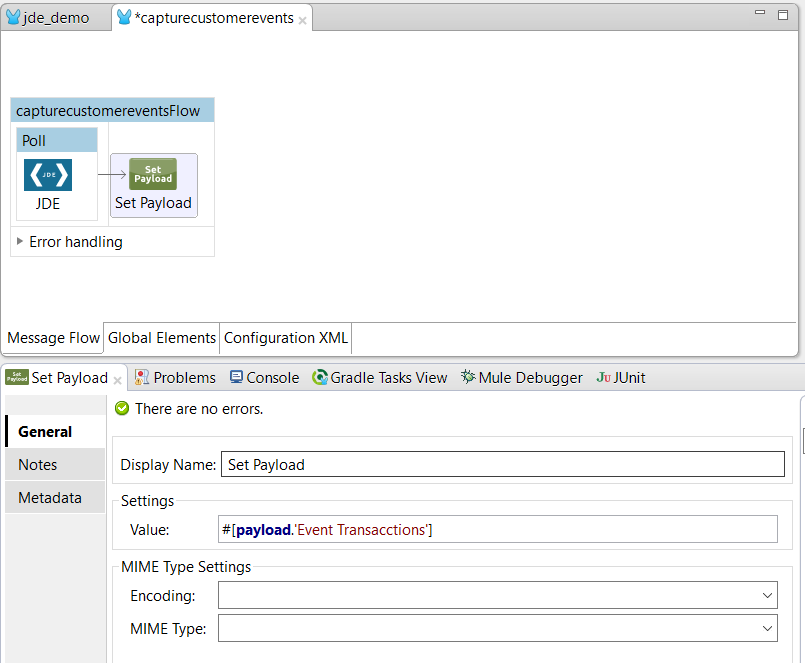
Step 8
Back to the Message Flow view, and you need to Locate the Filter Expression on the right hand-side palette to return the address book name.
Drag the component over to the canvas and write this value:
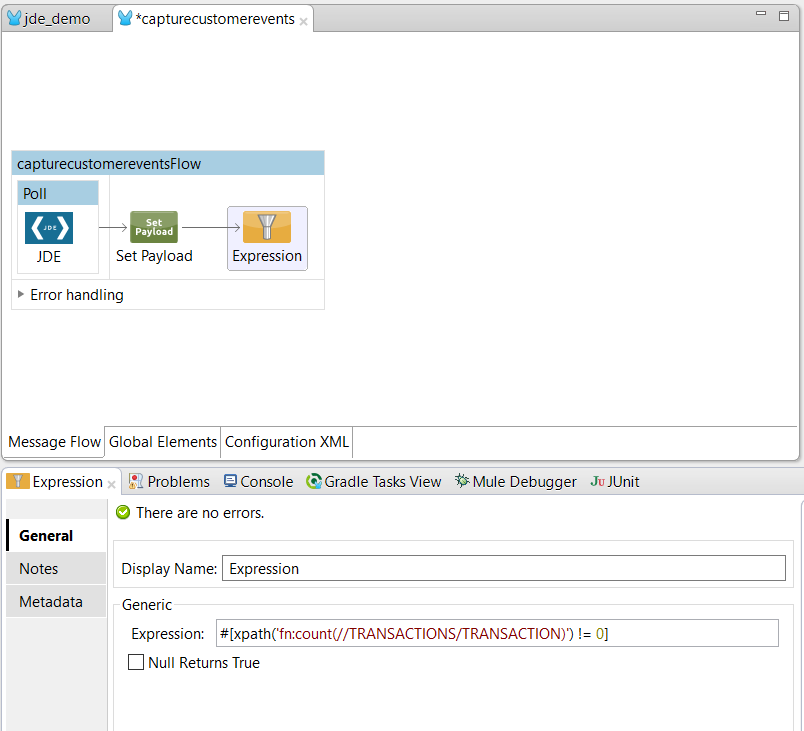
Step 9
Back to the Message Flow view, and you need to Locate the For Each on the right hand-side palette to return the address book name.
Drag the component over to the canvas and write this value:

Step 10
Back to the Message Flow view, and you need to Locate the Dom to XML on the right hand-side palette to return the address book name.
Drag the component over to the canvas:

Step 11
Back to the Message Flow view, and you need to Locate the Variable on the right hand-side palette to return the address book name.
Drag the component over to the canvas and write this variable Name and its value:
Name:
ediID
Value:
#[xpath3('//TRANSACTION[1]/@ETYPE',payload,'STRING')]_#[xpath3('//TRANSACTION[1]/@EDBT',payload,'STRING')]
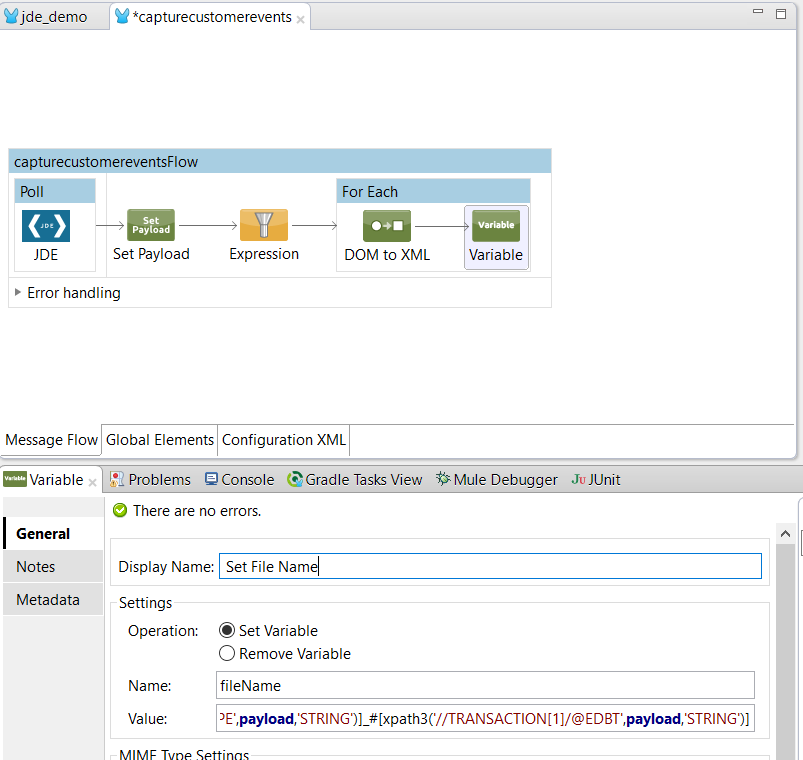
Step 12
Back to the Message Flow view, and you need to Locate the File on the right hand-side palette to return the address book name.
Drag the component over to the canvas and write this values:
Folder: demo File Name: events_outbound_#[ediID].xml Connector: create a new connector configuration
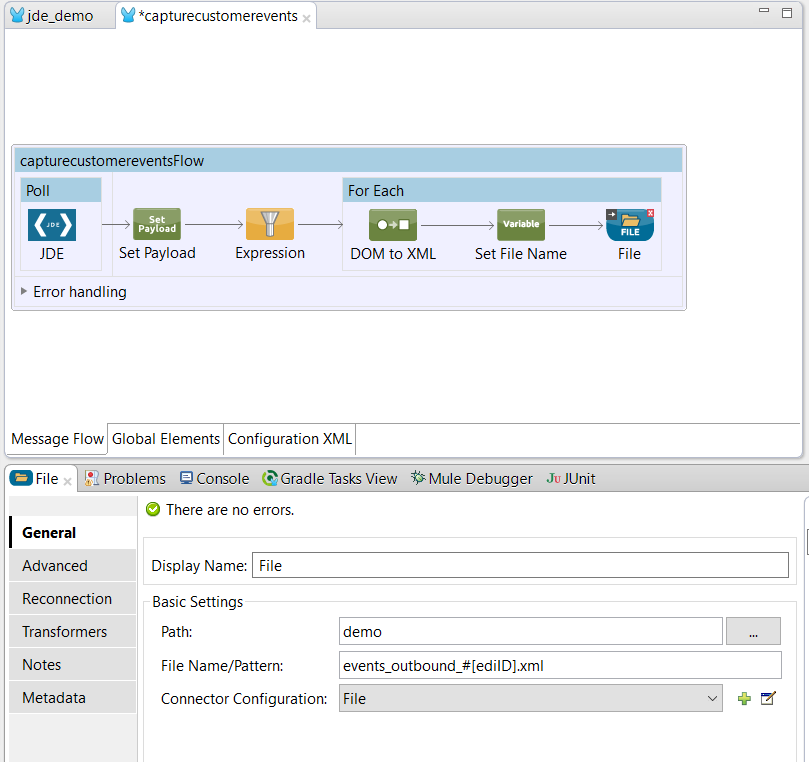
Step 13
Finally, run the example as a Mule application
Step 14
Enter a Customer using Customer Master information (P03013)
Step 15
Check file generated

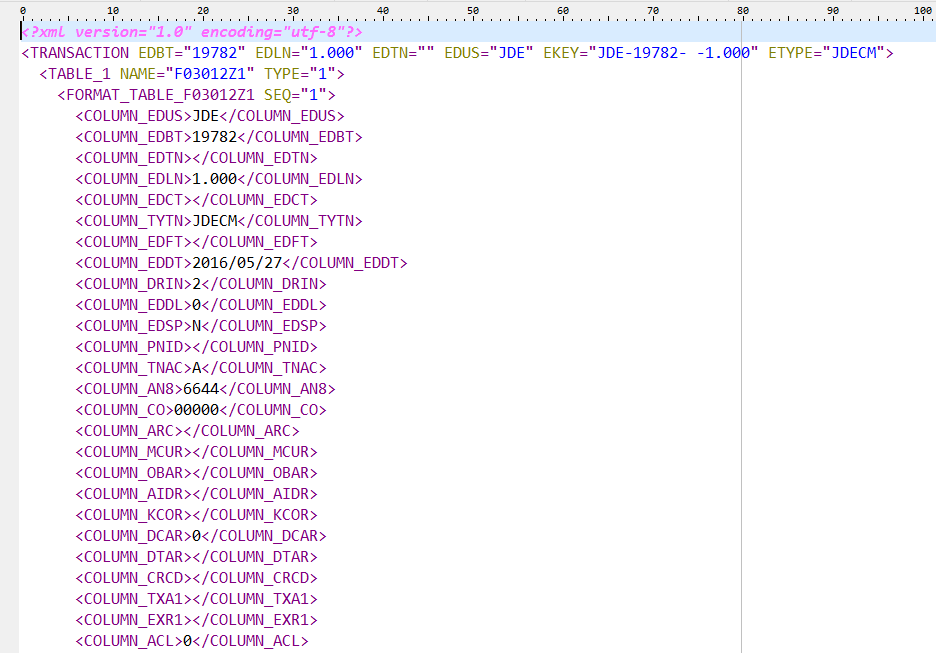
Demo Mule Applications Using Connector to capture EDI outbound events
This use case example will create a simple flow to generate a Order Acknowledgments (855/ORDRSP) document in a local folder.
| It’s important to read the guide: JD Edwards EnterpriseOne Applications Data Interface for Electronic Data Interchange Implementation Guide |
First, you need to create a new UBE version for R42565 or use standard XJDE0003 version.
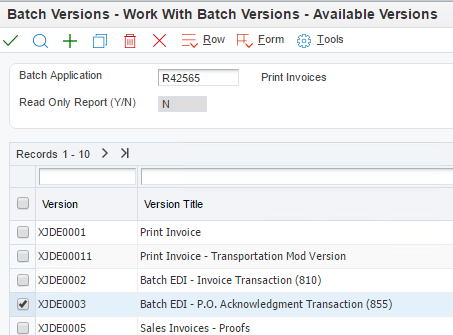
and configure Processing Options:
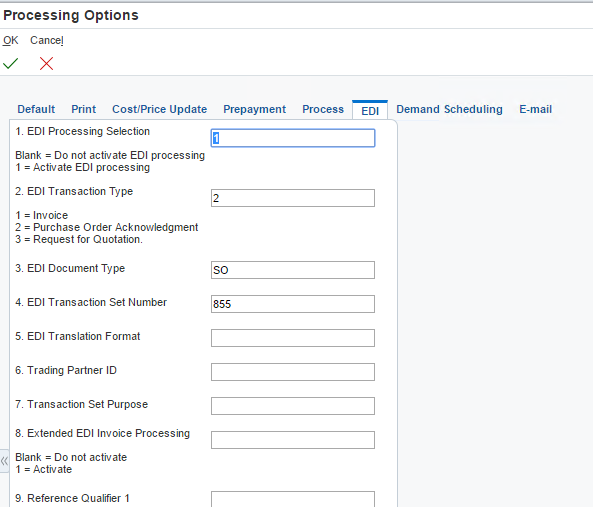
The last configuration that is needed is inform to JDE connector the EDI outbound:
Using "Flat File Cross-Reference (P47002)" form "Work With Flat File Cross-Reference" adds the following record:
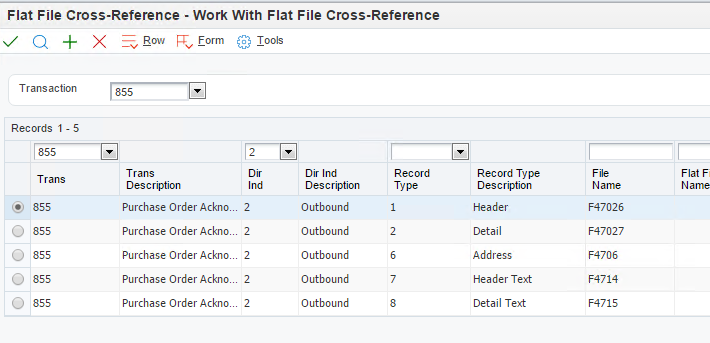
| Table | Record Type |
|---|---|
F47026 |
1 Header |
F47027 |
2 Detail |
F4706 |
6 Address |
F4714 |
7 Header Text |
F4715 |
8 Detail Text |
Follow next steps to create a flow that it will capture EDI outbound to generate EDI doc in a local folder.
Step 1
Use Mule Project created in the Section 4.2 Create Mule Project.
Step 2
Locate the Poll Endpoint connector on the right hand-side palette:

Step 3
Drag the JDE connector over to the canvas:

Step 4
You need to select the operation "EDI Outbounds"
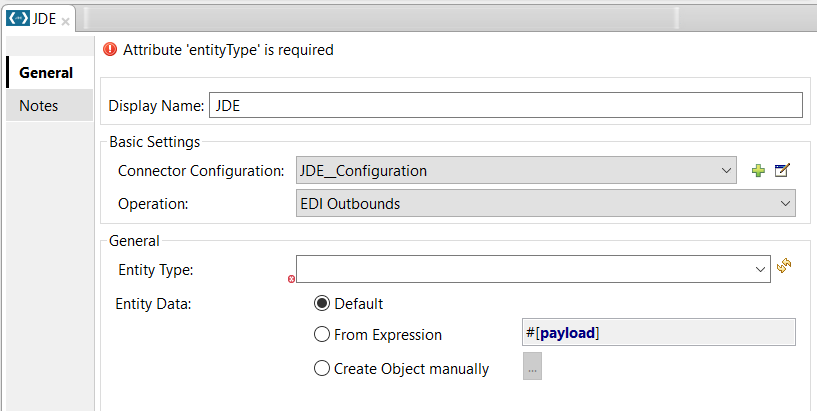
Step 5
Now, you need to select "Capure EDI Transactions" in the Entity Type field and press ENTER:
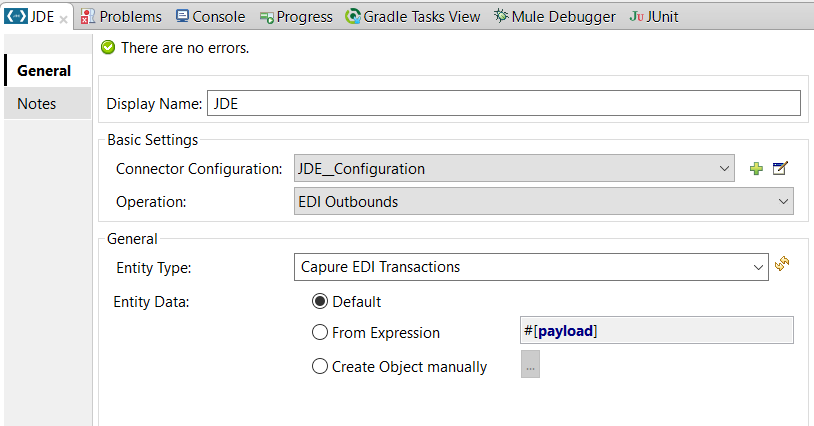
Step 6
Now, You will need to populate the parameters. To do this, you need to select the option: Create Object manually
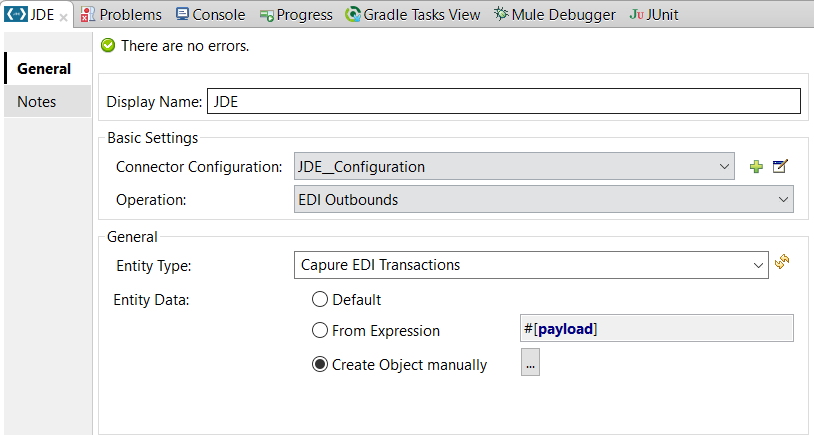
Press the button […] and populate the parameters:
EDI Code Enter 855 value
EDI Document Type Enter SO value
EDI Last EDI Document: Enter #[0L] value
EDI UBE-VERSION to update Transaction Enter R47027-XJDE0001 value. Standard UBE to update Order Acknowledgments
Max Qty Transactions to Read: Enter 10 value
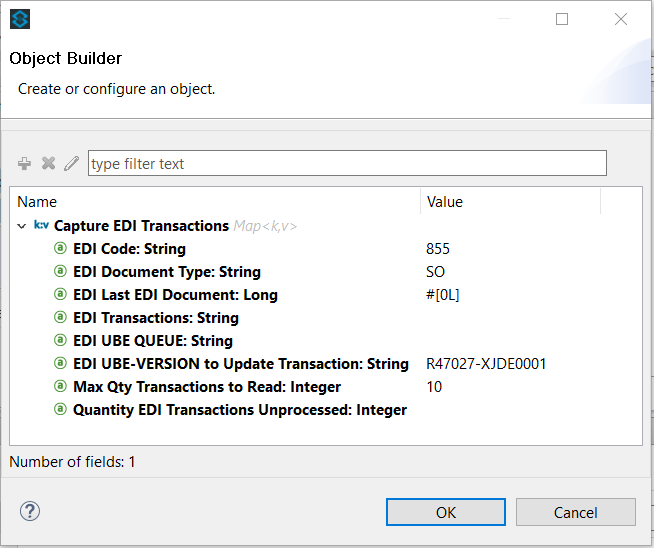
Press OK button to return to JDE Connector configuration. Save the project.
Step 7
Back to the Message Flow view, and you need to Locate the Set Payload on the right hand-side palette to return the address book name.
Drag the component over to the canvas and write this value:
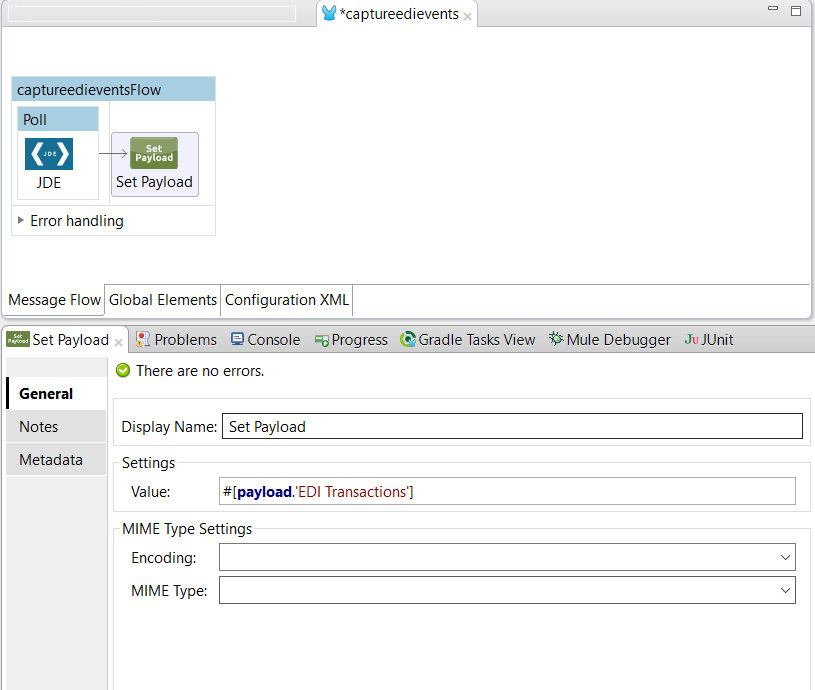
Step 8
Back to the Message Flow view, and you need to Locate the Filter Expression on the right hand-side palette to return the address book name.
Drag the component over to the canvas and write this value:
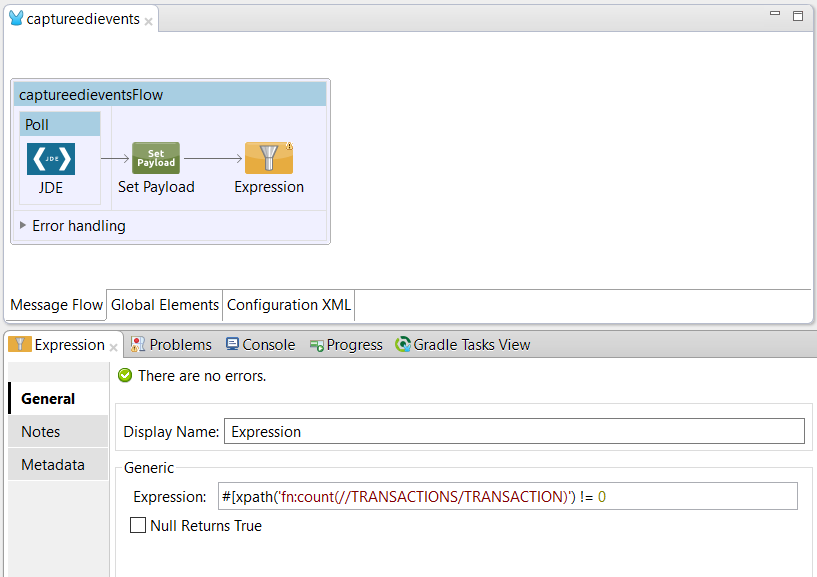
Enter this filter expression:
#[xpath('fn:count(//TRANSACTIONS/TRANSACTION)') != 0]
Step 9
Back to the Message Flow view, and you need to Locate the For Each on the right hand-side palette to return the address book name.
Drag the component over to the canvas and write this value:

Enter this Collection Expression:
#[xpath3('/TRANSACTIONS/TRANSACTION',payload,'NODESET')]
Step 10
Back to the Message Flow view, and you need to Locate the Dom to XML on the right hand-side palette to return the address book name.
Drag the component over to the canvas:

Step 11
Back to the Message Flow view, and you need to Locate the Variable on the right hand-side palette to return the address book name.
Drag the component over to the canvas and write this variable Name and its value:
Name:
ediID
Value:
#[xpath3('//TRANSACTION[1]/@ETYPE',payload,'STRING')]_#[xpath3('//TRANSACTION[1]/@EDOC',payload,'STRING')]

Step 12
Back to the Message Flow view, and you need to Locate the X12 on the right hand-side palette to return the address book name.
Drag the component over to the canvas and write this values:

Create a new Connector Configuration:
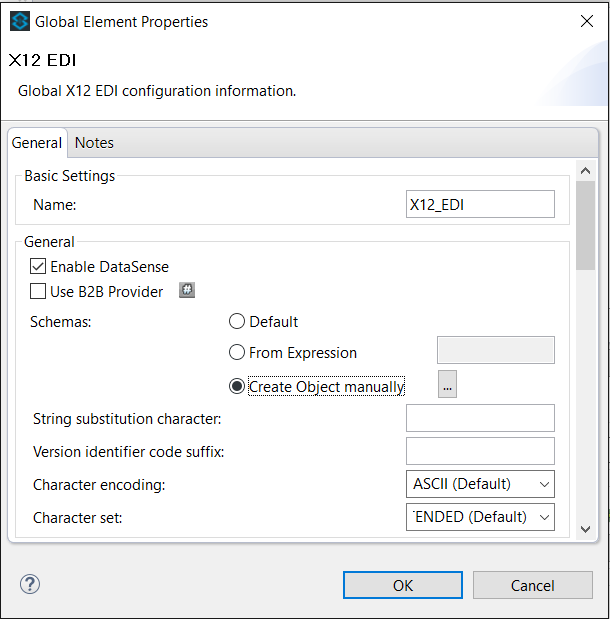
Select Schemas → Create Object manually and you need to add:
/x12/005010/855.esl
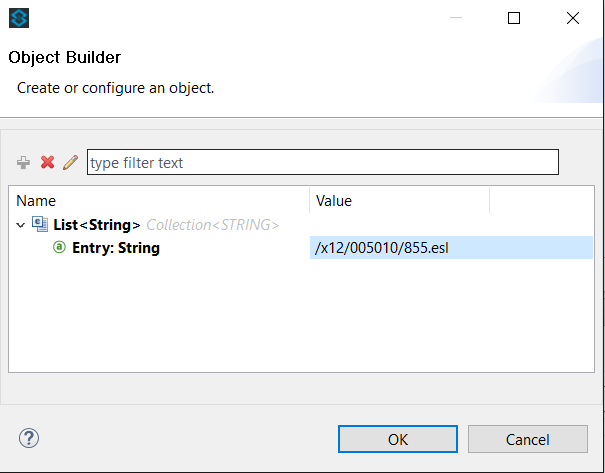
Then, you need to select Write Operation from Payload:
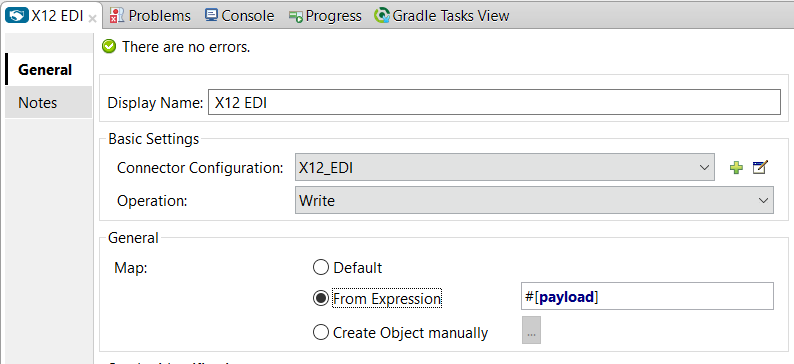
Now you need to configure Sender Identification and Receiver Identification:
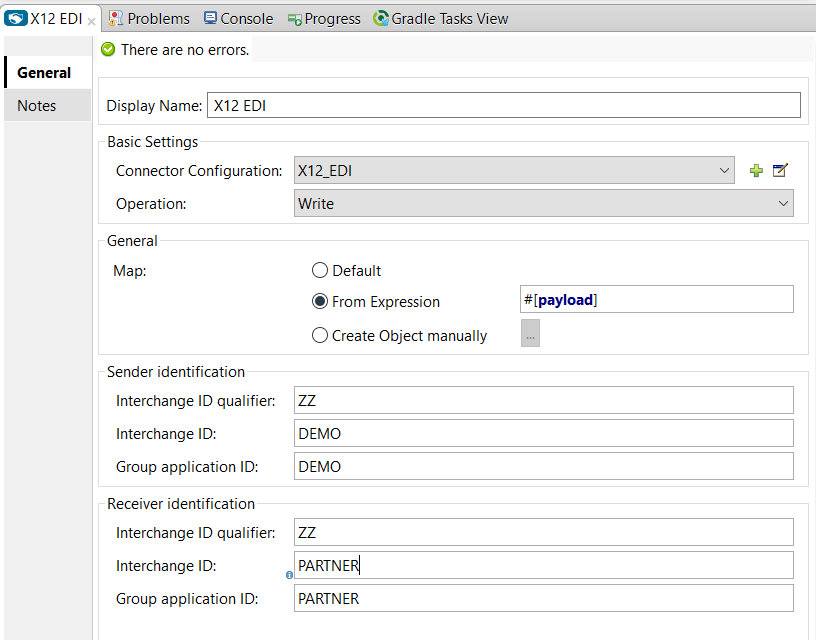
Step 13
Back to the Message Flow view, and you need to Locate the Transform Message on the right hand-side palette.
Drag the component over to the canvas between Variable and X12 component:

Switch to the XML view by clicking Configuration XML and replace CDATA element inside Transform Message definition with:
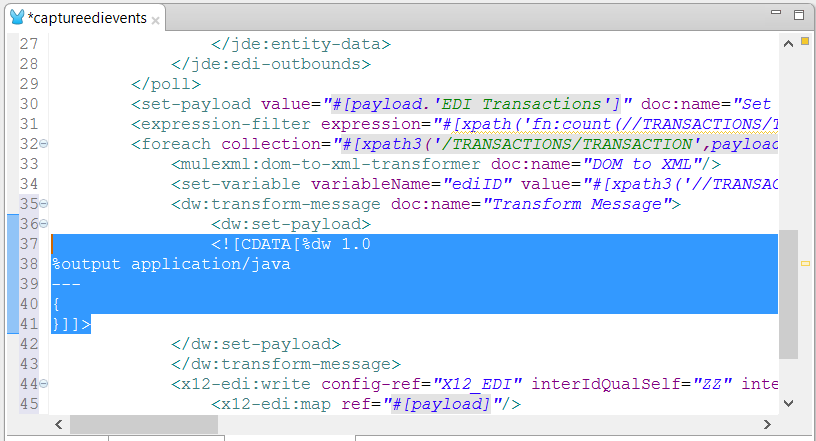
with
<![CDATA[%dw 1.0
%output application/java
%type mytime = :string { format: "HHMM" }
---
{
TransactionSets: {
v005010: {
"855": [{
Interchange: {
ISA01: "00",
ISA03: "00",
ISA05: "ZZ",
ISA06: "ModusBox",
ISA07: "ZZ",
ISA08: "Customer",
ISA09: now,
ISA10: now as :mytime as :number,
ISA11: "^",
ISA12: "00501",
ISA13: payload.TRANSACTION.@EDOC,
ISA14: "0",
ISA15: "P",
ISA16: ">"
},
Group: {
GS01: "PR",
GS02: "DEMO",
GS03: "PARTNER",
GS04: now,
GS05: now as :mytime as :number,
GS06: 1111,
GS07: "X",
GS08: "005010"
},
SetHeader: {
ST01: "855",
ST02: "530006100"
},
Heading: {
"0200_BAK": {
BAK01: "00",
BAK02: "AD",
BAK03: "PO01",
BAK04: now
}
},
Detail: {
"0100_PO1_Loop": payload.TRANSACTION.TABLE_2.*FORMAT_TABLE_F47027 map ((fORMATTABLEF47027 , indexOfFORMATTABLEF47027) -> {
"0100_PO1": {
PO102: fORMATTABLEF47027.COLUMN_UORG as :number,
PO103: fORMATTABLEF47027.COLUMN_UOM,
PO104: fORMATTABLEF47027.COLUMN_UPRC as :number,
PO105: "CP",
PO106: "CB",
PO107: fORMATTABLEF47027.COLUMN_LITM as :string
},
"0500_PID_Loop": [{
"0500_PID": {
PID01: "F",
PID05: fORMATTABLEF47027.COLUMN_DSC1 replace /,/ with ""
}
}]
})
},
Summary: {
"0100_CTT_Loop": {
"0100_CTT": {
CTT01: sizeOf payload.TRANSACTION.TABLE_2.*FORMAT_TABLE_F47027,
CTT02: 1
}
}
}
}]
}
}
}]]>Step 14
Back to the Message Flow view, and you need to Locate the File on the right hand-side palette to return the address book name.
Drag the component over to the canvas and write this values:
Folder: demo File Name: events_outbound_#[ediID].edi Connector: create a new connector configuration
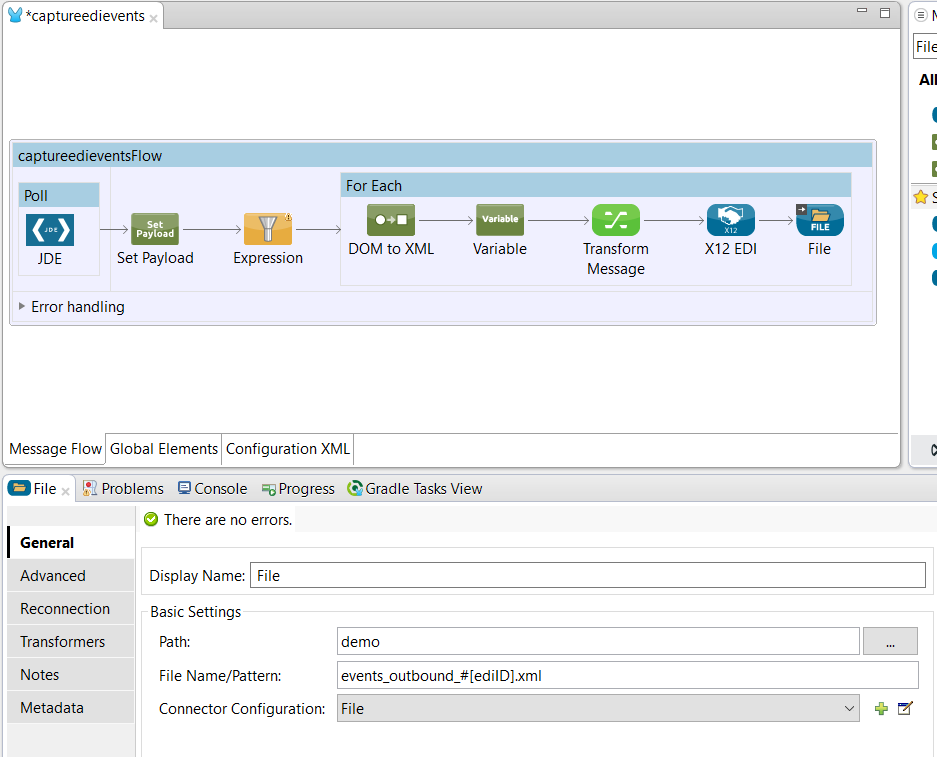
Step 15
Finally, run the example as a Mule application
Step 16
Enter a Sales Order and invoke UBE R42565 XJDE0003 [ Batch EDI - P.O. Acknowledgment Transaction (855) ] for the order generated.
Step 17
Check file generated

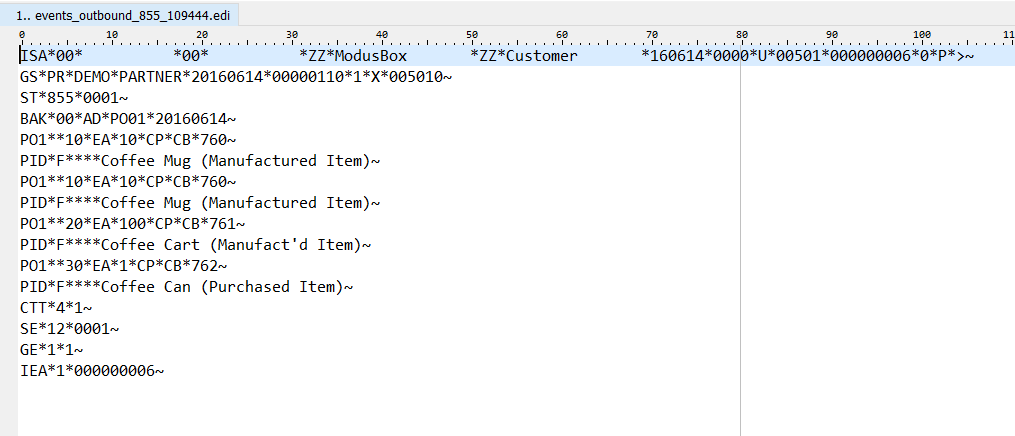
Connector Performance
To define the pooling profile for the connector manually, access the Pooling Profile tab in the applicable global element for the connector.
For background information on pooling, see Tuning Performance.
Resources
-
Access the JDE 1.1.0 Connector Release Notes.